Paul van Yperen's Blog, page 204
March 6, 2020
Five Filmshots by Film Weekly
The British magazine Film Weekly published an interesting postcard series: Filmshots. Four cards with scenes of a recent film. The series must have existed between ca. 1932 and 1934 and presents known and unknown American and British films of the early 1930s. An interesting period: Hollywood was still 'pre-code'. The Filmshots cards are simple: the pictures are in black and white and some basic credits are added: the (British) film title, the two main actors and the studio. At the backside, only the series title was printed: 'Filmshots by Film Weekly'. Recently I acquired five Filmshots that together show the range of the series.
By Candlelight (1933)
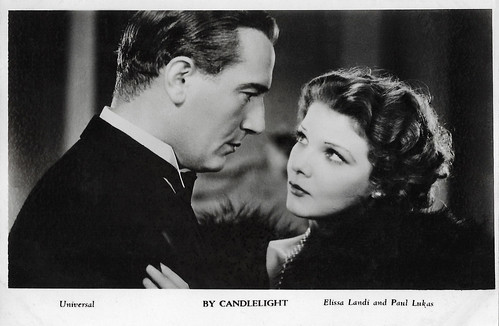
British postcard in the Film Shots series by Film Weekly. Photo: Universal. Paul Lukas and Elissa Landi in By Candlelight (James Whale, 1933).
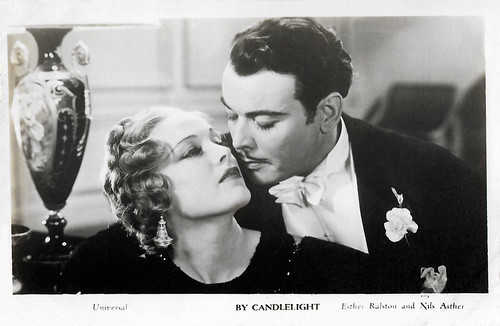
British postcard in the Film Shots series by Film Weekly. Photo: Universal. Nils Asther and Esther Ralston in By Candlelight (James Whale, 1933).
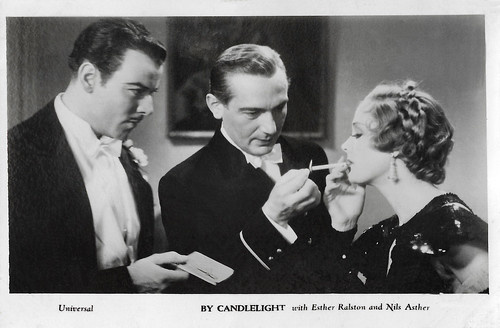
British postcard in the Film Shots series by Film Weekly. Photo: Universal. Nils Asther , Paul Lukas and Esther Ralston in By Candlelight (James Whale, 1933).
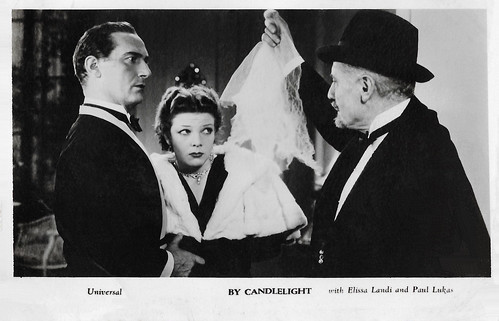
British postcard in the Film Shots series by Film Weekly. Photo: Universal. Paul Lukas and Elissa Landi in By Candlelight (James Whale, 1933).
By Candlelight (James Whale, 1933) is one of the sophisticated pre-code films revolving around a series of mistaken identities and misrepresentations. It is an adaptation of the Austrian play, 'Bei Kerzenlicht', by writers Siegfried Geyer and Karl Farkas. Josef ( Paul Lukas ) is the valet for Count von Rommer ( Nils Asther ) and well trained in the philandering ways of his master. Mistaken for the Count by a maid, Marie ( Elissa Landi ), whom he thinks is an aristocrat, Josef shows her a merry time in the Count's Monte Carlo villa. Meanwhile, the Count escapes a situation with Countess von Rischenheim (Dorothy Revier), when her husband Count von Rischenheim (Lawrence Grant) makes an unscheduled appearance, by posing as the butler.
Director Robert Wyler had failed to make a satisfactory start with By Candlelight so Universal asked James Whale to continue the film. Whale took Ted Kent, his favourite cutter, and John Mescall as the camera director. Whale started the film over from the beginning. He filmed the script as it was for the most part, but he also made a game of it, putting in his own special tricks of the trade. Producer Carl Laemmle was very happy with the result. He liked the film himself, and it brought in good money just in the nick of time to help save the studio once more, adding some good revenue to the spectacular revenues from Whale's The Invisible Man which were then really piling up. Mark Waltz at IMDb : "this art-deco gem, a fast-moving, well-acted comedy of manners (or lack of...). Lukas, who up to that point was known in Hollywood as the leading man of many women's films, proves himself to be much more debonair than presented in the past. With Landi, he shares some great scenes on a train ride where they mingle with common folk at a town fair. Landi is good in a drunk scene, but its Lukas and Asther who get acting honors here. Whale does a great job with every single detail from the sets, photography, and unmannered performances that remain fresh today as they were in 1933." Hal Erickson at AllMovie : "By Candlelight is chock full of delightfully double-entendre pre-Code dialogue and dextrous directorial touches".
Man of Two Worlds (1934)
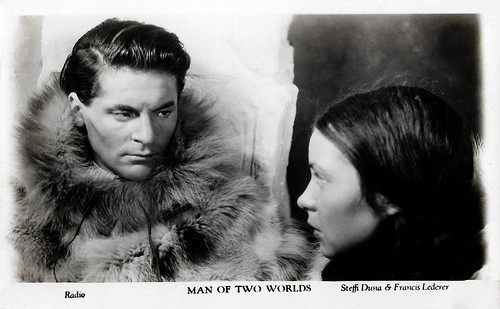
British postcard in the Film Shots series by Film Weekly. Photo: Radio (RKO). Steffi Duna and Francis Lederer in Man of Two Worlds (J. Walter Ruben, 1934).
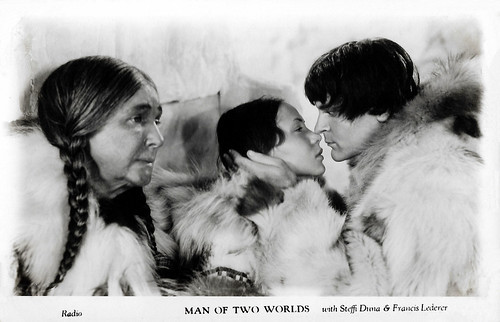
British postcard in the Film Shots series by Film Weekly. Photo: Radio (RKO). Steffi Duna and Francis Lederer in Man of Two Worlds (J. Walter Ruben, 1934).
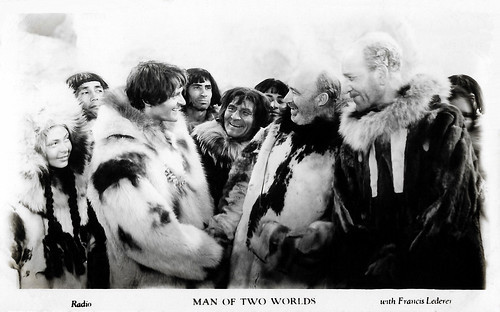
British postcard in the Film Shots series by Film Weekly. Photo: Radio (RKO). Francis Lederer in Man of Two Worlds (J. Walter Ruben, 1934).
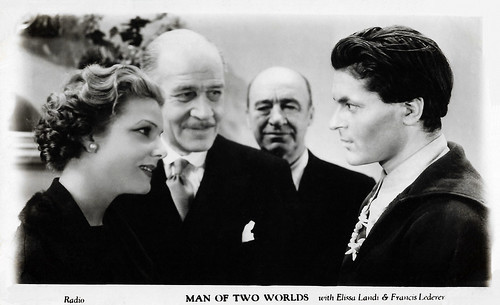
British postcard in the Film Shots series by Film Weekly. Photo: Radio (RKO). Elissa Landi , Henry Stephenson and Francis Lederer in Man of Two Worlds (J. Walter Ruben, 1934). In the background J. Farrell MacDonald.
With the success of Robert Flaherty's Nanook of the North (1922), Hollywood tried to replicate the box office by using Eskimo themes. In Man of Two Worlds (J. Walter Ruben, 1934) a British explorer (Henry Stephenson) in the Arctic hires a local Eskimo as an assistant. The earnest but unsophisticated young man called Aigo ( Francis Lederer ) happens to see a photograph of the explorer's beautiful daughter and falls in love with her. Soon afterward a medical emergency results in his being flown to London for treatment, where he finally meets the girl he has longed for. Once in Britain, Aigo is treated as a curiosity--like some sort of simple-minded thing instead of a person. He likes what he sees--particularly Sir Basil's daughter. In his mind, he's envisioned that she is destined to be his--and, of course, he's setting himself up for disappointment. No one seems to believe, including the girl, that Aigo has normal human desires and urges. The film was a box office disappointment for RKO.
Martin Hafer at IMDb : "Man of Two Worlds is the sort of film that no one would make today. It's very much a relic of the early 20th century and influenced by the real-life story of Minik, a native of Greenland brought back to Europe as a cultural curiosity--and who ended up wasting away and dying away from his native land. (...) Throughout this film, Aigo is treated in an amazingly patronizing fashion. He is some silly, childish savage--sort of like Tarzan but with even less intellect. Offensive? Yes, but also pretty dumb, as ANYONE with even average intelligence would recognize that he is a man and not a thing!" Bob Lipton at IMDb : "Modern attitudes towards different cultures may have changed in the seventy-five years since this movie came out, but it still is a good story and the modern viewer can, if he chooses, look upon it as an anthropological record of its own, a record of how the culture of Hollywood viewed other cultures back in its heyday." Danny at Pre-code.com : "You can tell Man of Two Worlds had a nice budget, though. The film makes use of a real polar bear for its animal scenes, and though on a sound stage, the sets are expansive and good looking. The scenes that take place in England are also less confined to interiors, making it feel freer and more visceral, something that Aigo himself is surely feeling as well. But really, the central performance in this film is so utterly awful and irredeemable, it’s a pain to even try and scrounge up compliments for it. Lacking a pulpy tone or a trace of nuance, Man of Two Worlds is creaky and laughable, an ‘important’ picture whose moral and central performances are now offensive and outdated. It’s a rare movie to find, and here’s my suggestion: don’t find it."
Luxury Liner (1933)
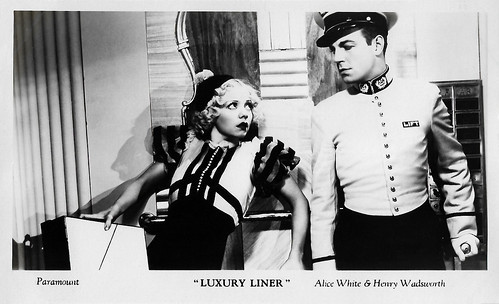
British postcard in the Film Shots series by Film Weekly. Photo: Paramount. Alice White and Henry Wadsworth in Luxury Liner (Lothar Mendes, 1933).
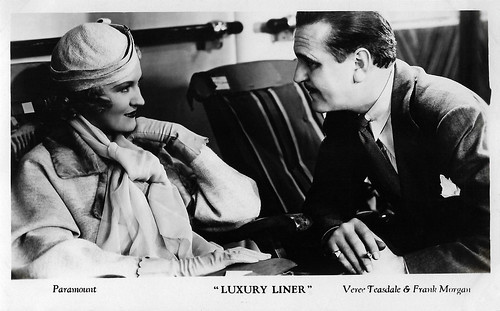
British postcard in the Film Shots series by Film Weekly. Photo: Paramount. Verree Teasdale and Frank Morgan in Luxury Liner (Lothar Mendes, 1933). On the card, the first name of Teasdale is written wrong.
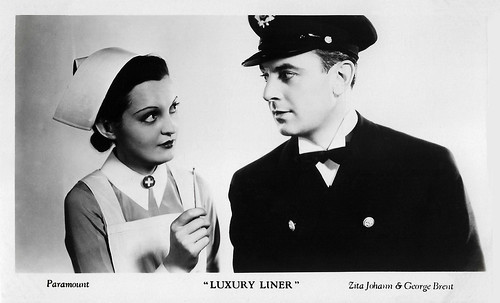
British postcard in the Film Shots series by Film Weekly. Photo: Paramount. Zita Johann and George Brent in Luxury Liner (Lothar Mendes, 1933).
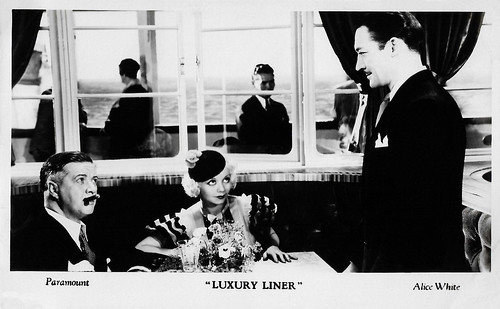
British postcard in the Film Shots series by Film Weekly. Photo: Paramount. Alice White in Luxury Liner (Lothar Mendes, 1933).
Luxury Liner (Lothar Mendes, 1933) is a kind of Grand Hotel (Edmund Goulding, 1932), a multi-story drama but now on the high seas. Based on a 1932 novel by Gina Kaus, it is an entertaining and multifaceted look into the various classes of cruise liner society with a very talented cast. The pre-code drama includes birth and death, lots of sexual innuendoes and a combination of comedy that drives the plot and drama that is often poignant. As the film begins the German-American cruise ship Germania is setting sail from Bremen to New York, with a stop in Cherbourg. Dr. Thomas Bernard (George Brent) begs a friend to find him a place aboard the ship, as his wife (Vivienne Osborne) has just left him and is supposed to be aboard. The Captain makes Bernard the ship's doctor and he will have to attend to 1001 different problems as they arise. Miss Morgan (Zita Johann) is the ship's nurse who never dates. Milli Stern (Alice White) is a third-class passenger who desperately wants to be in first class. Edward Thorndyke ( C. Aubrey Smith ) is a former millionaire who's just been released from jail, and millionaire Alex Stevenson (Frank Morgan) has Dr. Bernard's ex with him but wants to romance an opera singer. While Dr. Bernard fights to get his wife back, Milli comes up with a scheme to make money in the stock market. Of course, there is a lot of drama and fighting and a little romance.
Some of the IMDb reviewers liked the film: "The Paramount gloss is at its peak here." and "Alice White gives a delightful funny performance as a gold-digger and the film is worth watching just to see her." However, Mordaunt Hall, critic for The New York Times in 1933, was unimpressed, writing, "neither the story nor the dialogue live up to expectations. ... Mr. Mendes was evidently not inspired by the script furnished him and he fails to give more than a haphazard conception of the movement of the vessel, after the first quarter of the film. The attempt at levity is feeble and the clock-work-like manipulation of the happenings is often rather wearying." Hall felt there were "one or two competent performances by the principals" ( C. Aubrey Smith , Zita Johann and Vivienne Osborne), but thought that Frank Morgan was miscast and George Brent was "not at his best."
Pick-up (1933)
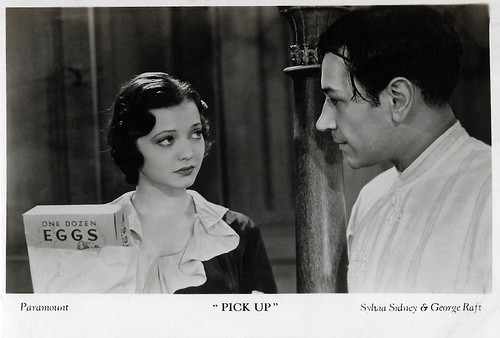
British postcard in the Film Shots series by Film Weekly. Photo: Paramount. Sylvia Sidney and George Raft in Pick-up (Marion Gering, 1933).

British postcard in the Film Shots series by Film Weekly. Photo: Paramount. Sylvia Sidney and George Raft in Pick-up (Marion Gering, 1933).
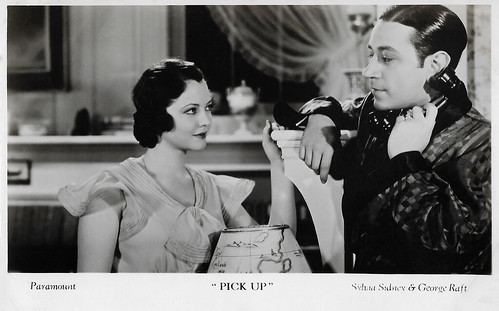
British postcard in the Film Shots series by Film Weekly. Photo: Paramount. Sylvia Sidney and George Raft in Pick-up (Marion Gering, 1933).
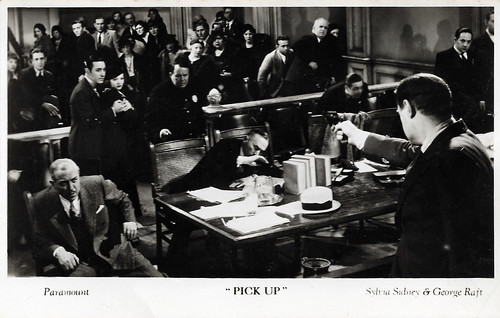
British postcard in the Film Shots series by Film Weekly. Photo: Paramount. Sylvia Sidney and George Raft in Pick-up (Marion Gering, 1933).
At one stage Pick-up (Marion Gering, 1933) was going to star Carole Lombard and Gary Cooper . Eventually, Sylvia Sidney and George Raft were cast, Raft replacing Cooper, who had been held up making a film at MGM. In the script by Viña Delmar, based on her own magazine serial, the scheme of a pair of married con artists (Sylvia Sidney and William Harrigan) goes awry when their victim dies, and they are both caught and imprisoned. When she gets out of prison after a two-year sentence, she tries to put her life back together. Harrigan still has three years to go. On a rainy night, Sidney bumps into George Raft, who plays an underachieving cab driver who is 'satisfied' with his low-rent life. He first thinks she's a prostitute, but after some hesitation, he invites her home. John Howard Reid at IMDb : "At this point, the movie should have stopped (...) between the noirish start and emotive conclusion of this film, we are treated to an irrelevant sub-plot about a depraved but super-lovely and filthy rich temptress (scorchingly played by Lillian Bond ) who sinks her fangs into Raft who, it turns out, is a sucker for rich and ritzy playgirls. Of course, this story allows Sidney to go through her patented pained and injured shtick (...) It seems to take forever for Harrigan to escape from jail and the main plot to start moving again. But when it does, it's a wow and certainly well worth waiting for!"
Bob Lipton at IMDb : "Sylvia Sidney was Paramount's low-class weeper star in this period, with a lower-class accent and a beautiful face that could suffer stoically or break out in helpless tears just when the plot demanded it. In this one, she has just gotten out of prison because she and her husband were involved in a badger game and one of their victims killed himself. Her husband is still in jail and she falls in with George Raft, whose hair is always perfect. They encounter various problems that keep getting worse and worse until they reach the point where you're ready to laugh - except that Miss Sidney is so perfect in these roles, that you simply want to hug her. George Raft is adequate and for those of you who like such thing, Charles Middleton, best known as Emperor Ming of Mongo is on hand." The film was a box office hit.
The Private Life of Henry VIII. (1933)
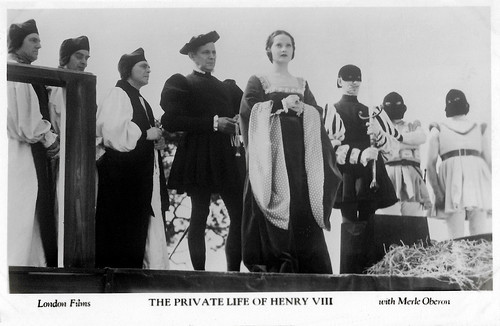
British postcard in the Filmshots series by Film Weekly. Photo: London Films. Merle Oberon in The Private Life of Henry VIII. (Alexander Korda, 1933).
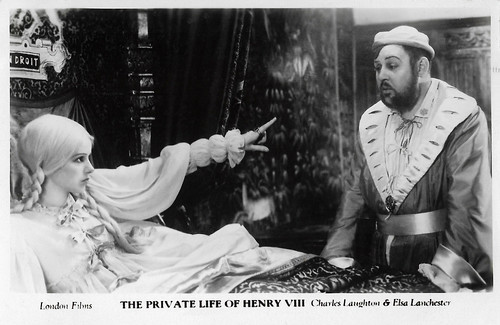
British postcard in the Filmshots series by Film Weekly. Photo: London Films. Charles Laughton and Elsa Lanchester in The Private Life of Henry VIII. (Alexander Korda, 1933).
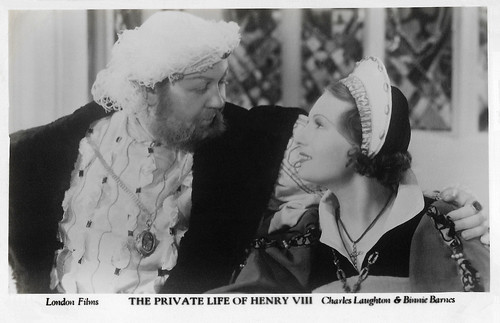
British postcard in the Filmshots series by Film Weekly. Photo: London Films. Charles Laughton and Binnie Barnes in The Private Life of Henry VIII. (Alexander Korda, 1933).
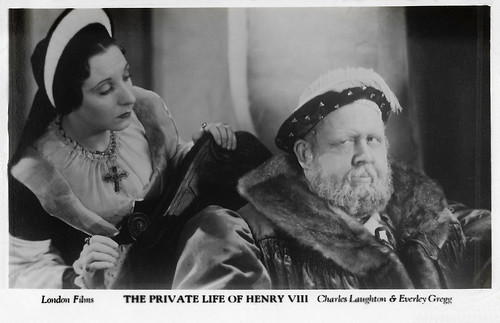
British postcard in the Filmshots series by Film Weekly. Photo: London Films. Charles Laughton and Everley Gregg in The Private Life of Henry VIII. (Alexander Korda, 1933).
The Private Life of Henry VIII. (Alexander Korda, 1933) is a rollicking historical biopic of the notorious love-life of Britain's most married monarch, Henry VIII. As the opening credits explain: "Henry VIII had six wives. Catherine of Aragon was the first; but her story is of no particular interest - she was a respectable woman-so Henry divorced her. He then married Anne Boleyn. This marriage also was a failure-but not for the same reason." Hungarian-born director Alexander Korda directed this British classic, based on a script and story by Lajos Biró (also from Hungary) and Arthur Wimperis, written for London Film Productions, Korda's production company. The film features a bravura performance by the young Charles Laughton as Henry. Of course, some historical cuts needed to be made for the 96-minute long film. So the film begins in May 1536, 20 years into King Henry's reign. His first wife Katherine Of Aragon is sidestepped completely and we only see her successor, the interesting and charismatic Anne Boleyn ( Merle Oberon ), as she readies herself for her beheading. Lejink at IMDb : "There's much ribald humour, quite racy for the time, in the utterings of the hoi-polloi at the queens' executions and amongst the King's serving staff, while the encounter with the exceeding ugly Anne Of Cleves (Elsa Lanchester) is played for laughs pretty much from the start." The direction is fast-moving and while telescoping a lot of history into its short running time, does so with wit and flair.
The Private Life of Henry VIII. (Alexander Korda, 1933) was the first British production to be nominated for the Academy Award for Best Picture, but it did not win this Oscar. However, it was still the first non-Hollywood film to win an Academy Award, as Charles Laughton won the 1933 Academy Award for Best Actor for his performance. The Private Life of Henry VIII. was a major international success, establishing Korda as a leading filmmaker and Laughton as a box office star. And Charles Laughton is indeed terrific in the title role. He portrays Henry during nearly twelve years - first as a virile, charming but dangerous man when he's young and as a crouching, old fool in his latest years when he fights to retain youth and yet ages badly due to ill-health. Laughton deservedly was awarded an Oscar for his role. Another highlight is Elsa Lanchester's memorably eccentric performance as Anne of Cleves. Lanchester, Laughton's real-life wife, plays Anne with a kind of flakey caginess that is funny, fascinating and original. Lanchester actually was lovely, but Anne figures her only way to avoid Henry's attentions is to push out her jaw and act dense when he talks about what her wifely duties entail. She and Laughton have a wonderful comic chemistry as they spend their wedding night playing cards, and it is especially fun to watch Laughton as his character gets some of his own back for all his serial marrying.
Sources: Hal Erickson (AllMovie), Mark Waltz (IMDb), Martin Hafer (IMDb), Bob Lipton (IMDb), Danny (Pre-code.com), John Howard Reid (IMDb), Lejink (IMDb), Wikipedia and IMDb.
Next week: five Filmshots by Film Weekly from the collection of Ivo Blom.
By Candlelight (1933)

British postcard in the Film Shots series by Film Weekly. Photo: Universal. Paul Lukas and Elissa Landi in By Candlelight (James Whale, 1933).

British postcard in the Film Shots series by Film Weekly. Photo: Universal. Nils Asther and Esther Ralston in By Candlelight (James Whale, 1933).

British postcard in the Film Shots series by Film Weekly. Photo: Universal. Nils Asther , Paul Lukas and Esther Ralston in By Candlelight (James Whale, 1933).

British postcard in the Film Shots series by Film Weekly. Photo: Universal. Paul Lukas and Elissa Landi in By Candlelight (James Whale, 1933).
By Candlelight (James Whale, 1933) is one of the sophisticated pre-code films revolving around a series of mistaken identities and misrepresentations. It is an adaptation of the Austrian play, 'Bei Kerzenlicht', by writers Siegfried Geyer and Karl Farkas. Josef ( Paul Lukas ) is the valet for Count von Rommer ( Nils Asther ) and well trained in the philandering ways of his master. Mistaken for the Count by a maid, Marie ( Elissa Landi ), whom he thinks is an aristocrat, Josef shows her a merry time in the Count's Monte Carlo villa. Meanwhile, the Count escapes a situation with Countess von Rischenheim (Dorothy Revier), when her husband Count von Rischenheim (Lawrence Grant) makes an unscheduled appearance, by posing as the butler.
Director Robert Wyler had failed to make a satisfactory start with By Candlelight so Universal asked James Whale to continue the film. Whale took Ted Kent, his favourite cutter, and John Mescall as the camera director. Whale started the film over from the beginning. He filmed the script as it was for the most part, but he also made a game of it, putting in his own special tricks of the trade. Producer Carl Laemmle was very happy with the result. He liked the film himself, and it brought in good money just in the nick of time to help save the studio once more, adding some good revenue to the spectacular revenues from Whale's The Invisible Man which were then really piling up. Mark Waltz at IMDb : "this art-deco gem, a fast-moving, well-acted comedy of manners (or lack of...). Lukas, who up to that point was known in Hollywood as the leading man of many women's films, proves himself to be much more debonair than presented in the past. With Landi, he shares some great scenes on a train ride where they mingle with common folk at a town fair. Landi is good in a drunk scene, but its Lukas and Asther who get acting honors here. Whale does a great job with every single detail from the sets, photography, and unmannered performances that remain fresh today as they were in 1933." Hal Erickson at AllMovie : "By Candlelight is chock full of delightfully double-entendre pre-Code dialogue and dextrous directorial touches".
Man of Two Worlds (1934)

British postcard in the Film Shots series by Film Weekly. Photo: Radio (RKO). Steffi Duna and Francis Lederer in Man of Two Worlds (J. Walter Ruben, 1934).

British postcard in the Film Shots series by Film Weekly. Photo: Radio (RKO). Steffi Duna and Francis Lederer in Man of Two Worlds (J. Walter Ruben, 1934).

British postcard in the Film Shots series by Film Weekly. Photo: Radio (RKO). Francis Lederer in Man of Two Worlds (J. Walter Ruben, 1934).

British postcard in the Film Shots series by Film Weekly. Photo: Radio (RKO). Elissa Landi , Henry Stephenson and Francis Lederer in Man of Two Worlds (J. Walter Ruben, 1934). In the background J. Farrell MacDonald.
With the success of Robert Flaherty's Nanook of the North (1922), Hollywood tried to replicate the box office by using Eskimo themes. In Man of Two Worlds (J. Walter Ruben, 1934) a British explorer (Henry Stephenson) in the Arctic hires a local Eskimo as an assistant. The earnest but unsophisticated young man called Aigo ( Francis Lederer ) happens to see a photograph of the explorer's beautiful daughter and falls in love with her. Soon afterward a medical emergency results in his being flown to London for treatment, where he finally meets the girl he has longed for. Once in Britain, Aigo is treated as a curiosity--like some sort of simple-minded thing instead of a person. He likes what he sees--particularly Sir Basil's daughter. In his mind, he's envisioned that she is destined to be his--and, of course, he's setting himself up for disappointment. No one seems to believe, including the girl, that Aigo has normal human desires and urges. The film was a box office disappointment for RKO.
Martin Hafer at IMDb : "Man of Two Worlds is the sort of film that no one would make today. It's very much a relic of the early 20th century and influenced by the real-life story of Minik, a native of Greenland brought back to Europe as a cultural curiosity--and who ended up wasting away and dying away from his native land. (...) Throughout this film, Aigo is treated in an amazingly patronizing fashion. He is some silly, childish savage--sort of like Tarzan but with even less intellect. Offensive? Yes, but also pretty dumb, as ANYONE with even average intelligence would recognize that he is a man and not a thing!" Bob Lipton at IMDb : "Modern attitudes towards different cultures may have changed in the seventy-five years since this movie came out, but it still is a good story and the modern viewer can, if he chooses, look upon it as an anthropological record of its own, a record of how the culture of Hollywood viewed other cultures back in its heyday." Danny at Pre-code.com : "You can tell Man of Two Worlds had a nice budget, though. The film makes use of a real polar bear for its animal scenes, and though on a sound stage, the sets are expansive and good looking. The scenes that take place in England are also less confined to interiors, making it feel freer and more visceral, something that Aigo himself is surely feeling as well. But really, the central performance in this film is so utterly awful and irredeemable, it’s a pain to even try and scrounge up compliments for it. Lacking a pulpy tone or a trace of nuance, Man of Two Worlds is creaky and laughable, an ‘important’ picture whose moral and central performances are now offensive and outdated. It’s a rare movie to find, and here’s my suggestion: don’t find it."
Luxury Liner (1933)

British postcard in the Film Shots series by Film Weekly. Photo: Paramount. Alice White and Henry Wadsworth in Luxury Liner (Lothar Mendes, 1933).

British postcard in the Film Shots series by Film Weekly. Photo: Paramount. Verree Teasdale and Frank Morgan in Luxury Liner (Lothar Mendes, 1933). On the card, the first name of Teasdale is written wrong.

British postcard in the Film Shots series by Film Weekly. Photo: Paramount. Zita Johann and George Brent in Luxury Liner (Lothar Mendes, 1933).

British postcard in the Film Shots series by Film Weekly. Photo: Paramount. Alice White in Luxury Liner (Lothar Mendes, 1933).
Luxury Liner (Lothar Mendes, 1933) is a kind of Grand Hotel (Edmund Goulding, 1932), a multi-story drama but now on the high seas. Based on a 1932 novel by Gina Kaus, it is an entertaining and multifaceted look into the various classes of cruise liner society with a very talented cast. The pre-code drama includes birth and death, lots of sexual innuendoes and a combination of comedy that drives the plot and drama that is often poignant. As the film begins the German-American cruise ship Germania is setting sail from Bremen to New York, with a stop in Cherbourg. Dr. Thomas Bernard (George Brent) begs a friend to find him a place aboard the ship, as his wife (Vivienne Osborne) has just left him and is supposed to be aboard. The Captain makes Bernard the ship's doctor and he will have to attend to 1001 different problems as they arise. Miss Morgan (Zita Johann) is the ship's nurse who never dates. Milli Stern (Alice White) is a third-class passenger who desperately wants to be in first class. Edward Thorndyke ( C. Aubrey Smith ) is a former millionaire who's just been released from jail, and millionaire Alex Stevenson (Frank Morgan) has Dr. Bernard's ex with him but wants to romance an opera singer. While Dr. Bernard fights to get his wife back, Milli comes up with a scheme to make money in the stock market. Of course, there is a lot of drama and fighting and a little romance.
Some of the IMDb reviewers liked the film: "The Paramount gloss is at its peak here." and "Alice White gives a delightful funny performance as a gold-digger and the film is worth watching just to see her." However, Mordaunt Hall, critic for The New York Times in 1933, was unimpressed, writing, "neither the story nor the dialogue live up to expectations. ... Mr. Mendes was evidently not inspired by the script furnished him and he fails to give more than a haphazard conception of the movement of the vessel, after the first quarter of the film. The attempt at levity is feeble and the clock-work-like manipulation of the happenings is often rather wearying." Hall felt there were "one or two competent performances by the principals" ( C. Aubrey Smith , Zita Johann and Vivienne Osborne), but thought that Frank Morgan was miscast and George Brent was "not at his best."
Pick-up (1933)

British postcard in the Film Shots series by Film Weekly. Photo: Paramount. Sylvia Sidney and George Raft in Pick-up (Marion Gering, 1933).

British postcard in the Film Shots series by Film Weekly. Photo: Paramount. Sylvia Sidney and George Raft in Pick-up (Marion Gering, 1933).

British postcard in the Film Shots series by Film Weekly. Photo: Paramount. Sylvia Sidney and George Raft in Pick-up (Marion Gering, 1933).

British postcard in the Film Shots series by Film Weekly. Photo: Paramount. Sylvia Sidney and George Raft in Pick-up (Marion Gering, 1933).
At one stage Pick-up (Marion Gering, 1933) was going to star Carole Lombard and Gary Cooper . Eventually, Sylvia Sidney and George Raft were cast, Raft replacing Cooper, who had been held up making a film at MGM. In the script by Viña Delmar, based on her own magazine serial, the scheme of a pair of married con artists (Sylvia Sidney and William Harrigan) goes awry when their victim dies, and they are both caught and imprisoned. When she gets out of prison after a two-year sentence, she tries to put her life back together. Harrigan still has three years to go. On a rainy night, Sidney bumps into George Raft, who plays an underachieving cab driver who is 'satisfied' with his low-rent life. He first thinks she's a prostitute, but after some hesitation, he invites her home. John Howard Reid at IMDb : "At this point, the movie should have stopped (...) between the noirish start and emotive conclusion of this film, we are treated to an irrelevant sub-plot about a depraved but super-lovely and filthy rich temptress (scorchingly played by Lillian Bond ) who sinks her fangs into Raft who, it turns out, is a sucker for rich and ritzy playgirls. Of course, this story allows Sidney to go through her patented pained and injured shtick (...) It seems to take forever for Harrigan to escape from jail and the main plot to start moving again. But when it does, it's a wow and certainly well worth waiting for!"
Bob Lipton at IMDb : "Sylvia Sidney was Paramount's low-class weeper star in this period, with a lower-class accent and a beautiful face that could suffer stoically or break out in helpless tears just when the plot demanded it. In this one, she has just gotten out of prison because she and her husband were involved in a badger game and one of their victims killed himself. Her husband is still in jail and she falls in with George Raft, whose hair is always perfect. They encounter various problems that keep getting worse and worse until they reach the point where you're ready to laugh - except that Miss Sidney is so perfect in these roles, that you simply want to hug her. George Raft is adequate and for those of you who like such thing, Charles Middleton, best known as Emperor Ming of Mongo is on hand." The film was a box office hit.
The Private Life of Henry VIII. (1933)

British postcard in the Filmshots series by Film Weekly. Photo: London Films. Merle Oberon in The Private Life of Henry VIII. (Alexander Korda, 1933).

British postcard in the Filmshots series by Film Weekly. Photo: London Films. Charles Laughton and Elsa Lanchester in The Private Life of Henry VIII. (Alexander Korda, 1933).

British postcard in the Filmshots series by Film Weekly. Photo: London Films. Charles Laughton and Binnie Barnes in The Private Life of Henry VIII. (Alexander Korda, 1933).

British postcard in the Filmshots series by Film Weekly. Photo: London Films. Charles Laughton and Everley Gregg in The Private Life of Henry VIII. (Alexander Korda, 1933).
The Private Life of Henry VIII. (Alexander Korda, 1933) is a rollicking historical biopic of the notorious love-life of Britain's most married monarch, Henry VIII. As the opening credits explain: "Henry VIII had six wives. Catherine of Aragon was the first; but her story is of no particular interest - she was a respectable woman-so Henry divorced her. He then married Anne Boleyn. This marriage also was a failure-but not for the same reason." Hungarian-born director Alexander Korda directed this British classic, based on a script and story by Lajos Biró (also from Hungary) and Arthur Wimperis, written for London Film Productions, Korda's production company. The film features a bravura performance by the young Charles Laughton as Henry. Of course, some historical cuts needed to be made for the 96-minute long film. So the film begins in May 1536, 20 years into King Henry's reign. His first wife Katherine Of Aragon is sidestepped completely and we only see her successor, the interesting and charismatic Anne Boleyn ( Merle Oberon ), as she readies herself for her beheading. Lejink at IMDb : "There's much ribald humour, quite racy for the time, in the utterings of the hoi-polloi at the queens' executions and amongst the King's serving staff, while the encounter with the exceeding ugly Anne Of Cleves (Elsa Lanchester) is played for laughs pretty much from the start." The direction is fast-moving and while telescoping a lot of history into its short running time, does so with wit and flair.
The Private Life of Henry VIII. (Alexander Korda, 1933) was the first British production to be nominated for the Academy Award for Best Picture, but it did not win this Oscar. However, it was still the first non-Hollywood film to win an Academy Award, as Charles Laughton won the 1933 Academy Award for Best Actor for his performance. The Private Life of Henry VIII. was a major international success, establishing Korda as a leading filmmaker and Laughton as a box office star. And Charles Laughton is indeed terrific in the title role. He portrays Henry during nearly twelve years - first as a virile, charming but dangerous man when he's young and as a crouching, old fool in his latest years when he fights to retain youth and yet ages badly due to ill-health. Laughton deservedly was awarded an Oscar for his role. Another highlight is Elsa Lanchester's memorably eccentric performance as Anne of Cleves. Lanchester, Laughton's real-life wife, plays Anne with a kind of flakey caginess that is funny, fascinating and original. Lanchester actually was lovely, but Anne figures her only way to avoid Henry's attentions is to push out her jaw and act dense when he talks about what her wifely duties entail. She and Laughton have a wonderful comic chemistry as they spend their wedding night playing cards, and it is especially fun to watch Laughton as his character gets some of his own back for all his serial marrying.
Sources: Hal Erickson (AllMovie), Mark Waltz (IMDb), Martin Hafer (IMDb), Bob Lipton (IMDb), Danny (Pre-code.com), John Howard Reid (IMDb), Lejink (IMDb), Wikipedia and IMDb.
Next week: five Filmshots by Film Weekly from the collection of Ivo Blom.
Published on March 06, 2020 22:00
March 5, 2020
Ralph Richardson
English actor Sir Ralph Richardson (1902-1983) was one of the theatrical knights of the 20th century. Though more closely associated with the theatre, he appeared over a period of 50 years in such film classics as The Fallen Idol (1948), Doctor Zhivago (1965), and Greystoke (1984).
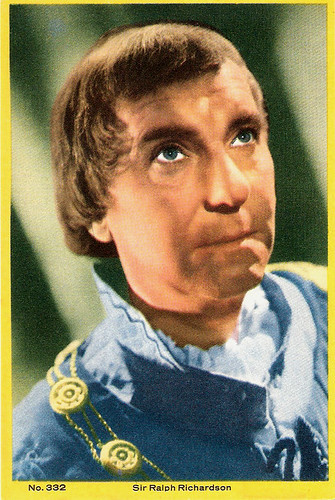
Mexican collectors card, no. 332.
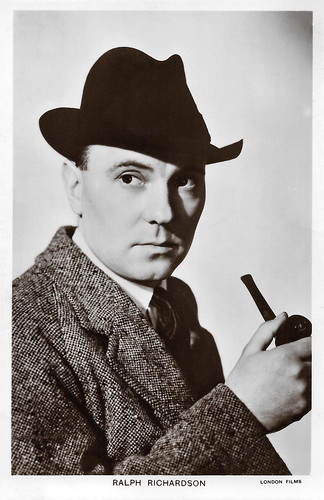
British postcard in the Picturegoer Series, London, no. 1216a. Photo: London Films. Ralph Richardson in Home at Seven (Ralph Richardson, 1952).
The First British Horror Film
Ralph David Richardson was born in Cheltenham, England, in 1902. He was the third son and youngest child of Arthur Richardson, a master at the Ladies' College and his wife Lydia née Russell. When he was a baby, his mother left his father and took him with her to Gloucester, where he was brought up in the Roman Catholic faith of his mother (his father and brothers were Quakers). His father supported them with a small allowance.
Lydia Richardson wished Ralph to become a priest. He was an altar boy in Brighton, and was sent to the Xavierian College, but he ran away from it. After working as an office boy for an insurance company, and later studying art, Richardson opted for a theatrical career. Aided by a small legacy from his grandmother, he paid a local theatrical manager ten shillings a week to be taught about acting.
He began his acting career at age 18 in The Merchant of Venice (1921) and toured with Charles Doran's company for five seasons, gradually being promoted to larger parts. In September 1924, Richardson married the seventeen-year-old student actress Muriel Hewitt. Their marriage was childless but devoted.
In 1925 he joined Sir Barry Jackson's Birmingham Repertory Company, where Richardson absorbed the influence of older contemporaries like Gerald du Maurier, and Mrs. Patrick Campbell . Richardson made his London debut in July 1926 as the stranger in Oedipus at Colonus in a small theatre, followed by his West End debut as Arthur Varwell in Yellow Sands which ran for 610 performances and from then to 1929 played in supporting roles in London productions.
After touring in South Africa in 1929, he played two seasons at the Old Vic and two seasons at the Malvern summer theatre. He pursued the great character roles. His Old Vic roles included Caliban to the Prospero of John Gielgud , beginning a professional association and friendship that lasted for five decades. Richardson's other parts in the Old Vic seasons included Bottom in A Midsummer Night's Dream, Petruchio in The Taming of the Shrew, Henry V, Brutus in Julius Caesar, and Iago in Othello.
In 1933 he made his film debut with a small part in the first British horror film of the sound era, The Ghoul (T. Hayes Hunter, 1933) starring Boris Karloff . He had a bigger part in the drama The King of Paris (Jack Raymond, 1934) starring Cedric Hardwicke . He had the leading part in the mystery The Return of Bulldog Drummond (Walter Summers, 1934) with Ann Todd .
Richardson became an undisputed West End star as Clitterhouse in Barré Lyndon's comedy melodrama, The Amazing Dr. Clitterhouse which ran for 492 performances from August 1936, and most of all as Johnson in J. B. Priestley's Johnson Over Jordan directed by Basil Dean, with music by Benjamin Britten. Richardson was engaged to play the role of Mercutio, replacing Orson Welles , in the 1934 Broadway production of Romeo and Juliet.
Richardson's film appearances include the Sci-Fi film Things to Come (William Cameron Menzies, 1936) which H.G. Wells adapted for the screen from his own novel, The Citadel (King Vidor, 1938) starring Robert Donat , and the adventure film The Four Feathers (Zoltan Korda, 1939). Brian MacFarlane writes in the Encyclopaedia of British Cinema : “Never handsome, he was always going to be a limited leading man in films and his 1930’s films tend to the eccentric or the character lead”.
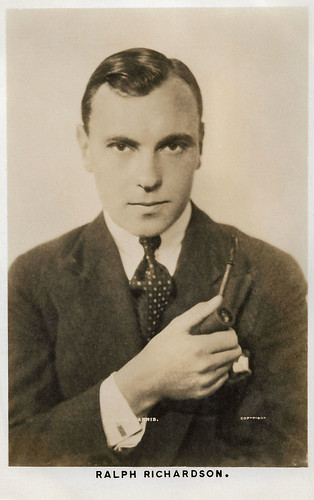
British postcard. Photo: Harris (?).
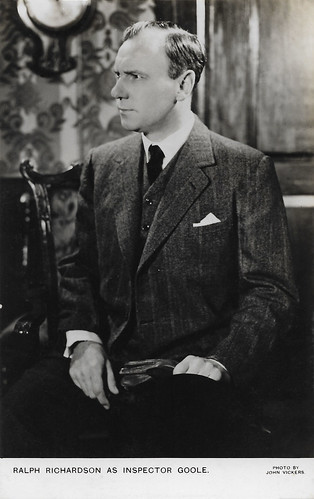
British postcard. Photo: John Vickers. Ralph Richardson in the stage play 'An Inspector Calls' (1946). An Inspector Calls is written by English dramatist J. B. Priestley, and was first performed in the Soviet Union in 1945. The play had its first British production in 1946 at the New Theatre in London with Ralph Richardson as Inspector Goole.
Missing the Greatest Play Of My Generation
During World War II, Ralph Richardson served in the Royal Naval Volunteer Reserve, where he rose to the rank of Lieutenant-Commander. Richardson and Laurence Olivier were released from the armed forces in 1944 to run the Old Vic company as a triumvirate with the stage director John Burrell. The Old Vic theatre was out of use because of bomb damage, and the company moved to the New Theatre in St. Martin's Lane.
During this period, Richardson gave some of his most noted performances, including Falstaff and Peer Gynt. He also directed Alec Guinness as Richard II. In 1945 Richardson and Olivier led the company in a tour of Germany, where they were seen by many thousands of servicemen; they also appeared at the Comédie Française in Paris.
In 1942, his first wife Muriel Hewitt contracted sleeping sickness and died after a long illness. Two years later Richardson married the actress Meriel Forbes, a member of the theatrical Forbes-Robertson family. They had one son, Charles David (1945-1998).
Richardson starred in the thriller The Fallen Idol (Carol Reed, 1948) with Michèle Morgan . Brian MacFarlane in the Encyclopaedia of British Cinema : “perhaps his finest screen work, full of subtle, suppressed longing and pain”. A year later he appeared as Olivia de Havilland ’s abusive father in The Heiress (William Wyler, 1949). This part resulted in his first nomination for an Academy Award as Best Supporting Actor.
In 1952 he co-starred with Ann Todd in the romantic war drama The Sound Barrier (David Lean, 1952). For this role he won the BAFTA Award for Best British Actor. He was nominated for a BAFTA on another three occasions (his last being for Greystoke in 1984). That year he also played an English minister in the heartwarming drama The Holly and the Ivy (George More O'Ferrall, 1952) with Celia Johnson .
In 1954 and 1955 Richardson played Dr. Watson in an American/BBC radio co-production of Sherlock Holmes stories, with John Gielgud as Holmes and Orson Welles as the villainous Professor Moriarty. Richardson turned down the role of Estragon in Peter Hall's premiere of the English-language version of Waiting for Godot and later reproached himself for missing the chance to be in ‘the greatest play of my generation’.
In the cinema he played Buckingham to Laurence Olivier 's Richard in Richard III (Laurence Olivier, 1955). Richardson's Timon of Athens in his 1956 return to the Old Vic was well received, as was his Broadway appearance in The Waltz of the Toreadors for which he was nominated for a Tony Award in 1957. Also successful were the films Our Man in Havana (Carol Reed, 1959), starring Alec Guinness , and Exodus (Otto Preminger, 1960) starring Paul Newman.
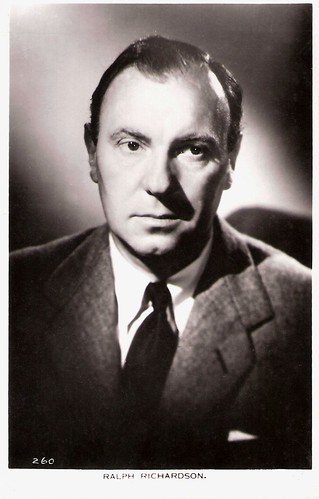
British postcard by Real Photograph, no. 260.
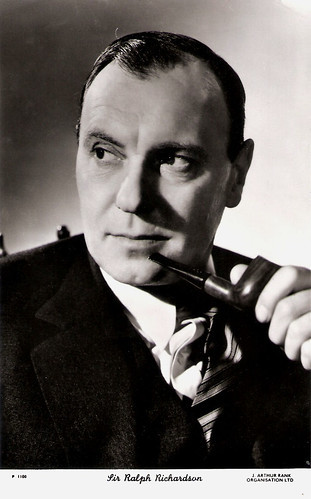
British postcard by Show Parade Picture Service in The People series, no. P. 1100. Photo: J. Arthur Rank Organisation Ltd.
Ulrich of Craggenmoor
In the 1960s, Ralph Richardson appeared successfully as Sir Peter Teazle in John Gielgud 's production of The School for Scandal, and the original production of Joe Orton's controversial farce What the Butler Saw in the West End at the Queen's Theatre in 1969 with Stanley Baxter.
Richardson played Lord Emsworth on BBC television in dramatisations of P. G. Wodehouse's Blandings Castle stories, with his wife Meriel Forbes playing his domineering sister Connie, and his friend Stanley Holloway as his butler Beach.
In 1963, Richardson won the Best Actor Award at the Cannes Film Festival for Long Day's Journey into Night (1962, Sidney Lumet). Author Eugene O'Neill gives in this film an autobiographical account of his explosive homelife, fused by a morphine-addicted mother ( Katharine Hepburn ), and a father (Richardson) who wallows in drink after realising he is no longer a famous actor.
Richardson also appeared in such film successes as Doctor Zhivago (David Lean, 1965), Oh! What a Lovely War (Richard Attenborough, 1969), and Battle of Britain (Guy Hamilton, 1969).
In the 1970s, he played in the West End and with the National Theatre under Peter Hall's direction. In the cinema he played in O Lucky Man! (Lindsay Anderson, 1973), the TV Mini-series Jesus of Nazareth (Franco Zeffirelli, 1977), and did a cameo appearance near the end of the Terry Gilliam film Time Bandits (1981).
Also that same year, he appeared as Ulrich of Craggenmoor, the ageing sorcerer who takes on an ancient dragon in the fantasy epic Dragonslayer (Matthew Robbins, 1981). Mike Cummings at AllMovie calls Richardson ‘one of his country's most celebrated eccentrics’: “Well into old age, he continued to enthrall audiences with his extraordinary acting skills - and to irritate neighbors with his noisy motorbike outings, sometimes with a parrot on his shoulder. He collected paintings, antiquities, and white mice.”
However, Richardson continued his long stage association with John Gielgud , appearing together in two new works, David Storey's Home and Harold Pinter's No Man's Land. His last stage appearance was at the National in the lead role in Eduardo De Filippo 's Inner Voices in June 1983.
In the cinema he played the sixth Earl of Greystoke in Greystoke: The Legend of Tarzan, Lord of the Apes (Hugh Hudson, 1984), for which he was again nominated for an Academy Award. His last film appearance was in Give My Regards to Broad Street (Peter Webb, 1984), starring Paul McCartney .
In 1983, Ralph Richardson died of a stroke, aged 80. Richardson was knighted in 1947, the first of his generation of actors to receive the accolade. He received Best Supporting Actor Oscar nominations for The Heiress and Greystoke, as well as New York Film Critics Circle and National Board of Review Awards for Best Actor for The Sound Barrier and another NYFCC Award for Best Supporting Actor for Greystoke. His Oscar nomination, BAFTA nomination and NYFCC Award for Greystoke were all posthumous.
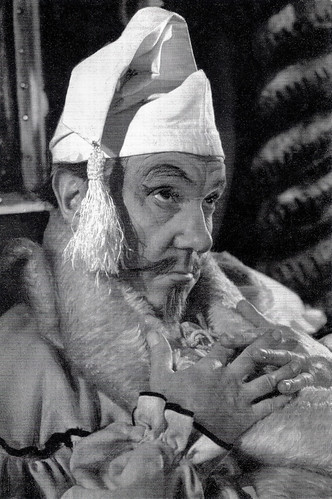
British postcard in the Shakespeare Memorial Theatre series, no. 19. Photo: Angus McBean. Caption: Ralph Richardson as Volpone, Stratford-upon-Avon, 1952.
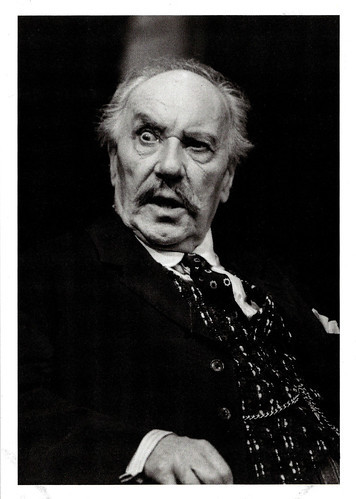
British postcard by NT (National Theatre). Photo: Alastair Muir. Ralph Richardson in the stage production of Inner Voices (1983) by Eduardo De Filippo at the Lyttelton Theatre.
Trailer The Fallen Idol (1948). Source: Trailer Chan (YouTube).
Theatrical trailer Richard III (1955). Source: Criterion Collection (YouTube).
Sources: Brian McFarlane (Encyclopaedia of British Cinema), Mike Cummings (AllMovie), Britannica.com, Wikipedia and .

Mexican collectors card, no. 332.

British postcard in the Picturegoer Series, London, no. 1216a. Photo: London Films. Ralph Richardson in Home at Seven (Ralph Richardson, 1952).
The First British Horror Film
Ralph David Richardson was born in Cheltenham, England, in 1902. He was the third son and youngest child of Arthur Richardson, a master at the Ladies' College and his wife Lydia née Russell. When he was a baby, his mother left his father and took him with her to Gloucester, where he was brought up in the Roman Catholic faith of his mother (his father and brothers were Quakers). His father supported them with a small allowance.
Lydia Richardson wished Ralph to become a priest. He was an altar boy in Brighton, and was sent to the Xavierian College, but he ran away from it. After working as an office boy for an insurance company, and later studying art, Richardson opted for a theatrical career. Aided by a small legacy from his grandmother, he paid a local theatrical manager ten shillings a week to be taught about acting.
He began his acting career at age 18 in The Merchant of Venice (1921) and toured with Charles Doran's company for five seasons, gradually being promoted to larger parts. In September 1924, Richardson married the seventeen-year-old student actress Muriel Hewitt. Their marriage was childless but devoted.
In 1925 he joined Sir Barry Jackson's Birmingham Repertory Company, where Richardson absorbed the influence of older contemporaries like Gerald du Maurier, and Mrs. Patrick Campbell . Richardson made his London debut in July 1926 as the stranger in Oedipus at Colonus in a small theatre, followed by his West End debut as Arthur Varwell in Yellow Sands which ran for 610 performances and from then to 1929 played in supporting roles in London productions.
After touring in South Africa in 1929, he played two seasons at the Old Vic and two seasons at the Malvern summer theatre. He pursued the great character roles. His Old Vic roles included Caliban to the Prospero of John Gielgud , beginning a professional association and friendship that lasted for five decades. Richardson's other parts in the Old Vic seasons included Bottom in A Midsummer Night's Dream, Petruchio in The Taming of the Shrew, Henry V, Brutus in Julius Caesar, and Iago in Othello.
In 1933 he made his film debut with a small part in the first British horror film of the sound era, The Ghoul (T. Hayes Hunter, 1933) starring Boris Karloff . He had a bigger part in the drama The King of Paris (Jack Raymond, 1934) starring Cedric Hardwicke . He had the leading part in the mystery The Return of Bulldog Drummond (Walter Summers, 1934) with Ann Todd .
Richardson became an undisputed West End star as Clitterhouse in Barré Lyndon's comedy melodrama, The Amazing Dr. Clitterhouse which ran for 492 performances from August 1936, and most of all as Johnson in J. B. Priestley's Johnson Over Jordan directed by Basil Dean, with music by Benjamin Britten. Richardson was engaged to play the role of Mercutio, replacing Orson Welles , in the 1934 Broadway production of Romeo and Juliet.
Richardson's film appearances include the Sci-Fi film Things to Come (William Cameron Menzies, 1936) which H.G. Wells adapted for the screen from his own novel, The Citadel (King Vidor, 1938) starring Robert Donat , and the adventure film The Four Feathers (Zoltan Korda, 1939). Brian MacFarlane writes in the Encyclopaedia of British Cinema : “Never handsome, he was always going to be a limited leading man in films and his 1930’s films tend to the eccentric or the character lead”.

British postcard. Photo: Harris (?).

British postcard. Photo: John Vickers. Ralph Richardson in the stage play 'An Inspector Calls' (1946). An Inspector Calls is written by English dramatist J. B. Priestley, and was first performed in the Soviet Union in 1945. The play had its first British production in 1946 at the New Theatre in London with Ralph Richardson as Inspector Goole.
Missing the Greatest Play Of My Generation
During World War II, Ralph Richardson served in the Royal Naval Volunteer Reserve, where he rose to the rank of Lieutenant-Commander. Richardson and Laurence Olivier were released from the armed forces in 1944 to run the Old Vic company as a triumvirate with the stage director John Burrell. The Old Vic theatre was out of use because of bomb damage, and the company moved to the New Theatre in St. Martin's Lane.
During this period, Richardson gave some of his most noted performances, including Falstaff and Peer Gynt. He also directed Alec Guinness as Richard II. In 1945 Richardson and Olivier led the company in a tour of Germany, where they were seen by many thousands of servicemen; they also appeared at the Comédie Française in Paris.
In 1942, his first wife Muriel Hewitt contracted sleeping sickness and died after a long illness. Two years later Richardson married the actress Meriel Forbes, a member of the theatrical Forbes-Robertson family. They had one son, Charles David (1945-1998).
Richardson starred in the thriller The Fallen Idol (Carol Reed, 1948) with Michèle Morgan . Brian MacFarlane in the Encyclopaedia of British Cinema : “perhaps his finest screen work, full of subtle, suppressed longing and pain”. A year later he appeared as Olivia de Havilland ’s abusive father in The Heiress (William Wyler, 1949). This part resulted in his first nomination for an Academy Award as Best Supporting Actor.
In 1952 he co-starred with Ann Todd in the romantic war drama The Sound Barrier (David Lean, 1952). For this role he won the BAFTA Award for Best British Actor. He was nominated for a BAFTA on another three occasions (his last being for Greystoke in 1984). That year he also played an English minister in the heartwarming drama The Holly and the Ivy (George More O'Ferrall, 1952) with Celia Johnson .
In 1954 and 1955 Richardson played Dr. Watson in an American/BBC radio co-production of Sherlock Holmes stories, with John Gielgud as Holmes and Orson Welles as the villainous Professor Moriarty. Richardson turned down the role of Estragon in Peter Hall's premiere of the English-language version of Waiting for Godot and later reproached himself for missing the chance to be in ‘the greatest play of my generation’.
In the cinema he played Buckingham to Laurence Olivier 's Richard in Richard III (Laurence Olivier, 1955). Richardson's Timon of Athens in his 1956 return to the Old Vic was well received, as was his Broadway appearance in The Waltz of the Toreadors for which he was nominated for a Tony Award in 1957. Also successful were the films Our Man in Havana (Carol Reed, 1959), starring Alec Guinness , and Exodus (Otto Preminger, 1960) starring Paul Newman.

British postcard by Real Photograph, no. 260.

British postcard by Show Parade Picture Service in The People series, no. P. 1100. Photo: J. Arthur Rank Organisation Ltd.
Ulrich of Craggenmoor
In the 1960s, Ralph Richardson appeared successfully as Sir Peter Teazle in John Gielgud 's production of The School for Scandal, and the original production of Joe Orton's controversial farce What the Butler Saw in the West End at the Queen's Theatre in 1969 with Stanley Baxter.
Richardson played Lord Emsworth on BBC television in dramatisations of P. G. Wodehouse's Blandings Castle stories, with his wife Meriel Forbes playing his domineering sister Connie, and his friend Stanley Holloway as his butler Beach.
In 1963, Richardson won the Best Actor Award at the Cannes Film Festival for Long Day's Journey into Night (1962, Sidney Lumet). Author Eugene O'Neill gives in this film an autobiographical account of his explosive homelife, fused by a morphine-addicted mother ( Katharine Hepburn ), and a father (Richardson) who wallows in drink after realising he is no longer a famous actor.
Richardson also appeared in such film successes as Doctor Zhivago (David Lean, 1965), Oh! What a Lovely War (Richard Attenborough, 1969), and Battle of Britain (Guy Hamilton, 1969).
In the 1970s, he played in the West End and with the National Theatre under Peter Hall's direction. In the cinema he played in O Lucky Man! (Lindsay Anderson, 1973), the TV Mini-series Jesus of Nazareth (Franco Zeffirelli, 1977), and did a cameo appearance near the end of the Terry Gilliam film Time Bandits (1981).
Also that same year, he appeared as Ulrich of Craggenmoor, the ageing sorcerer who takes on an ancient dragon in the fantasy epic Dragonslayer (Matthew Robbins, 1981). Mike Cummings at AllMovie calls Richardson ‘one of his country's most celebrated eccentrics’: “Well into old age, he continued to enthrall audiences with his extraordinary acting skills - and to irritate neighbors with his noisy motorbike outings, sometimes with a parrot on his shoulder. He collected paintings, antiquities, and white mice.”
However, Richardson continued his long stage association with John Gielgud , appearing together in two new works, David Storey's Home and Harold Pinter's No Man's Land. His last stage appearance was at the National in the lead role in Eduardo De Filippo 's Inner Voices in June 1983.
In the cinema he played the sixth Earl of Greystoke in Greystoke: The Legend of Tarzan, Lord of the Apes (Hugh Hudson, 1984), for which he was again nominated for an Academy Award. His last film appearance was in Give My Regards to Broad Street (Peter Webb, 1984), starring Paul McCartney .
In 1983, Ralph Richardson died of a stroke, aged 80. Richardson was knighted in 1947, the first of his generation of actors to receive the accolade. He received Best Supporting Actor Oscar nominations for The Heiress and Greystoke, as well as New York Film Critics Circle and National Board of Review Awards for Best Actor for The Sound Barrier and another NYFCC Award for Best Supporting Actor for Greystoke. His Oscar nomination, BAFTA nomination and NYFCC Award for Greystoke were all posthumous.

British postcard in the Shakespeare Memorial Theatre series, no. 19. Photo: Angus McBean. Caption: Ralph Richardson as Volpone, Stratford-upon-Avon, 1952.

British postcard by NT (National Theatre). Photo: Alastair Muir. Ralph Richardson in the stage production of Inner Voices (1983) by Eduardo De Filippo at the Lyttelton Theatre.
Trailer The Fallen Idol (1948). Source: Trailer Chan (YouTube).
Theatrical trailer Richard III (1955). Source: Criterion Collection (YouTube).
Sources: Brian McFarlane (Encyclopaedia of British Cinema), Mike Cummings (AllMovie), Britannica.com, Wikipedia and .
Published on March 05, 2020 22:00
March 4, 2020
Frans de Munck
Dutch soccer player and manager Frans de Munck (1922-2010) was also a one-time film star. In 1958, the goalkeeper was with his club DOS champion of the Netherlands. 'The Black Panter' also played for Fortuna '54, VV Goes, Sittard Boys, FC Köln, Veendam and SC Cambuur. The handsome De Munck appeared in a German film and he gave a legendary kiss to Jayne Mansfield.

German postcard by Kunst und Bild, Berlin, no. A 1012. Photo: Arthur Grimm / BBF / Nordfilm / Allianz Film. Publicity still for Das ideale Brautpaar/The perfect couple (Robert A. Stemmle, 1954).
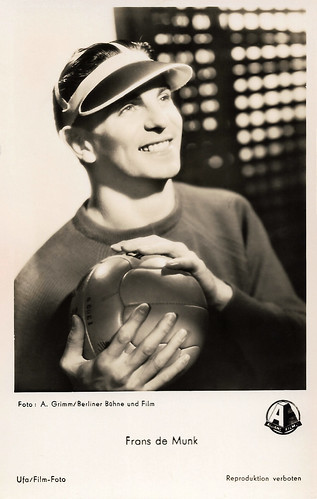
German postcard by Ufa/Film-Foto, Berlin-Tempelhof, no. FK 749. Photo: Arthur Grimm / BBF (Berliner Bühne und Film) / Allianz Film. Publicity still for Das ideale Brautpaar/The perfect couple (Robert A. Stemmle, 1954).
Cat-like Reflexes
Soccer player Frans de Munck was born in 1922. He was goalkeeper at several soccer clubs including VV Goes, the German FC Köln, BV Veendam and SC Cambuur.
'The Black Panther', played 31 matches for the Dutch national team. In 1949, he made his international debut in a friendly international against France. 'Orange' won the game with 4-1.
De Munck acquired his nickname 'The Black Panther' because of his legendary charismatic appearance - his striking black hair and trademark black shirt - and his cat-like reflexes.
In March 1953, De Munck took part in the famous 'flood event' between France and the Dutch national team in Paris. That event was intended to collect money for victims of the disastrous floods which had hit the southern Netherlands earlier that year and in which more than 1,800 people were killed.
Orange went to Paris with a team consisting of professionals who worked abroad. At the time, soccer was an amateur game in the Netherlands and the 1953 charity international is seen as one of the catalysts which led to professional Dutch football. The match ended in 2-1 for Holland. Just one year later, the first professional soccer match was played in the Netherlands.
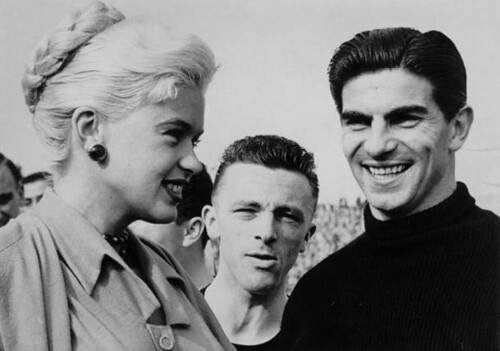
When Jayne met The Black Panther... DOS player Cor Luiten watches how the two flirt. Source: Poedie @ Flickr.
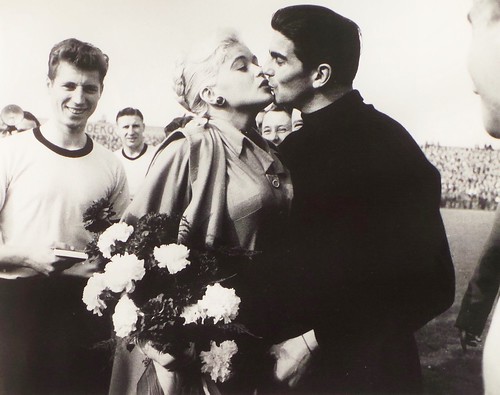
A shot of The Kiss before the soccer game Sparta - DOS Utrecht in Rotterdam on 13 October 1957. DOS players Tonny van der Linden en Gerrit Krommert watched it happen. The game ended 1-7. Source: Poedie @ Flickr.
A Sensational Kiss
In the early fifties, when soccer was still seen as an amateur sports in the Netherlands, Frans de Munck was for one year suspended by the KNVB (Royal Dutch Soccer Union) because he would have had money from his club Sittard Boys.
De Munck then went to the German club FC Köln, and he became very popular in Germany. He was called 'Der erste Star' (The First Star), a David Beckham avant-la-lettre.
The handsome goalkeeper even appeared in the film Das ideale Brautpaar/The perfect couple (Robert A. Stemmle, 1954), a romantic comedy starring Ingeborg Körner and Peter Mosbacher . De Munck played a famous keeper, Jürgen Busse
He returned to the Netherlands and played between 1954 and 1957 for Fortuna '54 and from 1957 till 1961 for DOS in Utrecht.
In 1957, famous Hollywood star Jayne Mansfield visited the Netherlands for a publicity tour. The Black Panther was the only DOS-player who was allowed to kiss the platinum blonde bombshell for the kickoff of the match Sparta - DOS.
The kiss created quite a stir in the Lowlands. Years later, De Munck told about The Kiss: "And I was not even captain of DOS!"
After his active football career, Frans de Munck worked from 1966 till 1974 as a coach at Vitesse in the Netherlands, and at Club Brugge and Lierse SK in Belgium.
In 2010, Frans de Munck passed away in Arnhem, The Netherlands. He was 88.
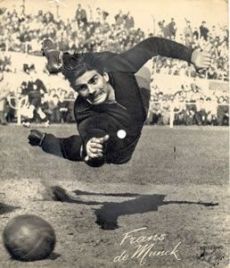
Photo: Jaap J. Herschel. At the World Press Photo 1957 exhibition, this photo was chosen as the Best Dutch Sports Photo of the Year. Source: Zeeland blog.
Sources: Renate Verhoofstad (AD) (Dutch), Volkskrant (Dutch), Voortschrijdende Inzichten (Dutch), RNW, Wikipedia (Dutch and English) and .

German postcard by Kunst und Bild, Berlin, no. A 1012. Photo: Arthur Grimm / BBF / Nordfilm / Allianz Film. Publicity still for Das ideale Brautpaar/The perfect couple (Robert A. Stemmle, 1954).

German postcard by Ufa/Film-Foto, Berlin-Tempelhof, no. FK 749. Photo: Arthur Grimm / BBF (Berliner Bühne und Film) / Allianz Film. Publicity still for Das ideale Brautpaar/The perfect couple (Robert A. Stemmle, 1954).
Cat-like Reflexes
Soccer player Frans de Munck was born in 1922. He was goalkeeper at several soccer clubs including VV Goes, the German FC Köln, BV Veendam and SC Cambuur.
'The Black Panther', played 31 matches for the Dutch national team. In 1949, he made his international debut in a friendly international against France. 'Orange' won the game with 4-1.
De Munck acquired his nickname 'The Black Panther' because of his legendary charismatic appearance - his striking black hair and trademark black shirt - and his cat-like reflexes.
In March 1953, De Munck took part in the famous 'flood event' between France and the Dutch national team in Paris. That event was intended to collect money for victims of the disastrous floods which had hit the southern Netherlands earlier that year and in which more than 1,800 people were killed.
Orange went to Paris with a team consisting of professionals who worked abroad. At the time, soccer was an amateur game in the Netherlands and the 1953 charity international is seen as one of the catalysts which led to professional Dutch football. The match ended in 2-1 for Holland. Just one year later, the first professional soccer match was played in the Netherlands.

When Jayne met The Black Panther... DOS player Cor Luiten watches how the two flirt. Source: Poedie @ Flickr.

A shot of The Kiss before the soccer game Sparta - DOS Utrecht in Rotterdam on 13 October 1957. DOS players Tonny van der Linden en Gerrit Krommert watched it happen. The game ended 1-7. Source: Poedie @ Flickr.
A Sensational Kiss
In the early fifties, when soccer was still seen as an amateur sports in the Netherlands, Frans de Munck was for one year suspended by the KNVB (Royal Dutch Soccer Union) because he would have had money from his club Sittard Boys.
De Munck then went to the German club FC Köln, and he became very popular in Germany. He was called 'Der erste Star' (The First Star), a David Beckham avant-la-lettre.
The handsome goalkeeper even appeared in the film Das ideale Brautpaar/The perfect couple (Robert A. Stemmle, 1954), a romantic comedy starring Ingeborg Körner and Peter Mosbacher . De Munck played a famous keeper, Jürgen Busse
He returned to the Netherlands and played between 1954 and 1957 for Fortuna '54 and from 1957 till 1961 for DOS in Utrecht.
In 1957, famous Hollywood star Jayne Mansfield visited the Netherlands for a publicity tour. The Black Panther was the only DOS-player who was allowed to kiss the platinum blonde bombshell for the kickoff of the match Sparta - DOS.
The kiss created quite a stir in the Lowlands. Years later, De Munck told about The Kiss: "And I was not even captain of DOS!"
After his active football career, Frans de Munck worked from 1966 till 1974 as a coach at Vitesse in the Netherlands, and at Club Brugge and Lierse SK in Belgium.
In 2010, Frans de Munck passed away in Arnhem, The Netherlands. He was 88.

Photo: Jaap J. Herschel. At the World Press Photo 1957 exhibition, this photo was chosen as the Best Dutch Sports Photo of the Year. Source: Zeeland blog.
Sources: Renate Verhoofstad (AD) (Dutch), Volkskrant (Dutch), Voortschrijdende Inzichten (Dutch), RNW, Wikipedia (Dutch and English) and .
Published on March 04, 2020 22:00
March 3, 2020
Jean Hervé
Jean Hervé (1884-1966) was a French stage and screen actor, known for his work at the Comédie-Française but also for his parts in Film d'Art cinema, the Rocambole films, and such classics as La Terre (1921) and Feu Mathias Pascal (1926).
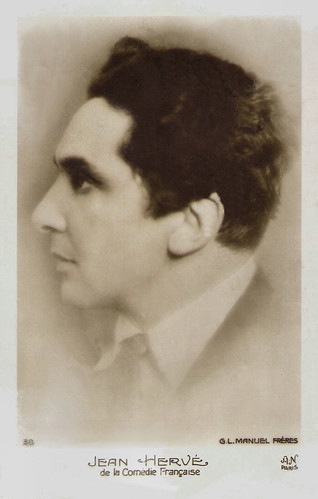
French postcard by A.N. (A. Noyer), Paris, no. 38. Photo: G.L. Manuel Frères. Jean Hervé de la Comédie Française.
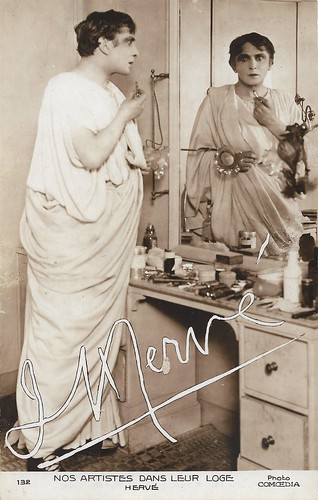
French postcard in the Nos artistes dans leur loge series, no. 132. Photo: Comoedia.
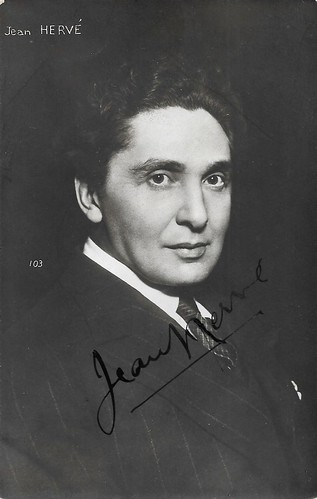
French postcard, no. 103. On the back, the logo of postcard printer Guilleminot.
A rich film career
Jean Hervé was born in 1884 in Paris.
He made his mark in 1910 with the open air staging of the lyrical tragedy 'Héliogabale' by Déodat de Séverac at the Théâtre des Arènes in Béziers. While Edouard de Max had the lead, and René Alexandre played the hero Rusca who conquers the emperor, Hervé played his friend Claudius. The stage production was accompanied by many ballet acts.
In the early 1910s, Hervé worked for years at the Théâtre de l'Odéon, directed by André Antoine, Firmin Gémier and others. In 1919 he entered the Comédie-Française and between 1925 and 1941, he was Sociétaire there. After 1941 and until the early 1960s he acted at various theatres, in particular at the Théâtre Hébertot and the Odéon.
Jean Hervé also had a rich film career. In 1908 he debuted in the Lux production La fille du braconnier/The poacher's daughter (Gérard Bourgeois, 1908). From 1912 on, he acted in a few Film d'Art films. He was Nero in the Racine adaptation Brittanicus (Camille de Morlhon, 1912), and Bassanio in the William Shakespeare adaption Shylock (Henri Desfontaines, 1913), starring Harry Baur and Pepa Bonafé.
He also acted in the Eclipse production La légende d'Oedipe/Oedipus Rex (Gaston Roudès, 1913), starring Mounet-Sully whose big stage role this had been. At Pathé Frères, Hervé also acted in modern drama: he had the lead in Trente ans ou la vie d'un joueur/Thirty Years of a Gambler's Life (Adrien Caillard, Georges Monca, 1912), about a young husband who falls in the clutches of an evil friend (Georges Tréville), who makes him gamble, wrecks his marriage and almost causes him to kill his own son.
Lacking at IMDb is the Pathé film La Closerie des genêts (Adrien Caillard, 1913), in which he acted opposite Léon Bernard and Sarah Davids, who also acted in the previous film. In 1914 Hervé had a major supporting part in the Pathé episode film Rocambole, shot in 1913 and released in 1914 subsequently as La Jeunesse de Rocambole/Rocambole, Les Exploits de Rocambole/Le Nouveau Rocambole, and Rocambole et l'héritage du marquis de Morfontain. The films were based on the work by Pierre Alexis de Ponson du Terrail, and directed by Georges Denola. While Gaston Silvestre played the title role, Hervé played Armand de Kergaz, Andrée Pascal his wife, Madeleine Céliat was Baccarat, and Tréville co-acted in this film too.
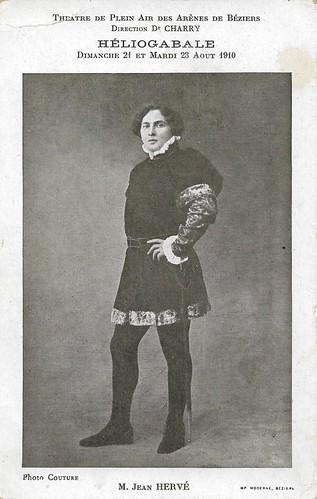
French postcard by MP Moderne, Béziers. Photo: Couture. Jean Hervé in the play 'Héliogabale', directed by Joseph Charry, at the open air Théâtre des Arènes in Béziers on 21 and 23 August 1910.
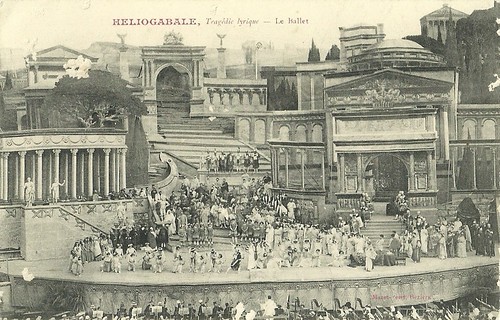
French postcard. Ballet of the lyrical tragedy 'Héliogabale', on 21 and 23 August 1910 at the Théàtre des Arènes in Béziers. Music was by Déodat de Séverac, Émile Sicard was auteur of the play, while director of the performance was Joseph Charry. Leading actors were Édouard de Max , Madeleine Roch, René Alexandre and Jean Hervé.
Kees van Dongen
After an absence of several years, Jean Hervé returned to the screen in 1920 with - the lost film - Fumée noire/Black Smoke, Louis Delluc's first film, made with his newly founded company Parisia, and co-directed with the more experienced director René Coiffard, who had worked in the US film industry. Star of the film was Eve Francis , Delluc's wife and favourite actress, but Hervé had the male lead.
The plot dealt with a couple of newlyweds whose uncle visits them, back from the Orient. His tales and gifts create dreams that seem to become reality. The production was ambitious, with paintings on the sets painted by Dutch artist Kees van Dongen, then one of the most popular modern artists of Paris.
From then Hervé was back in the picture, acting opposite Pierre Alcover in Le drame des eaux mortes/The drama of the dead waters (Joseph Faivre, 1921), but more important was his part as the evil, ruthless Buteau, harassing his sister's wife Françoise ( Germaine Rouer ) with fatal consequences, in La Terre/The Earth (1921) by André Antoine. Antoine kept Émile Zola's Naturalism by mixing the main actors from the Comédie-Française - who act in a restrained, realist way - with nonprofessionals, and by combining an updated version of 'King Lear' with the picturesque scenery of the French countryside, beautifully cinematographed.
Also released in 1921, were Herve's parts in La vivante épingle/The living pin (Jacques Robert, 1921) and L'étrange aventure du Docteur Works/The Closed Door (Robert Saidreau, 1921). Hervé last role in silent cinema was that of the evil Cavaliere Terenzio Papiano opposite Ivan Mozzhukhin in the title role and Lois Moran as Adriana/Adrienne in the Luigi Pirandello adaptation Feu Mathias Pascal/The Living Dead Man (Marcel L'Herbier, 1926).
Jean Hervé also directed four films ( IMDb only names three): Les deux chemins/The Two Roads (1918) with Manuel Caméré and Juliette Clarens, the Prosper Mérimée adaptation Colomba (1920) starring Mirella Marcovici, Le pauvre village/The poor village (1922) starring Max Maxudian and Germaine Rouer , and shot in Switzerland, and the WWI drama Les deux soldats/The Two Soldiers (1923), for which he also wrote the script.
In the sound era, Hervé mostly played on stage, but he still acted in two more films. He was Talma in Sacha Guitry 's Le destin fabuleux de Désirée Clary/Mlle. Desiree (1942), with Gaby Morlay in the title role, and he had a small role in the Fernandel comedy Adhémar ou le jouet de la fatalité/Adhémar (1951), again by Guitry. Hervé also acted in the TV film Mon coeur est dans les Highlands/My Heart is in the Highlands (Maurice Cazeneuve, 1953) with Roger Hanin .
Jean Hervé died in 1966 in Paris.
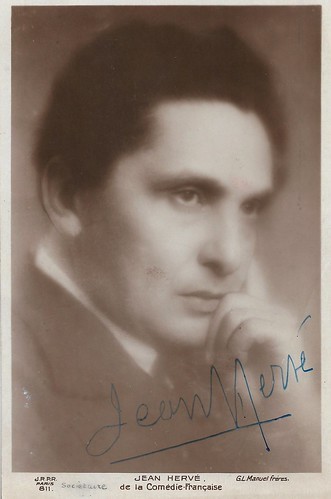
French postcard by J.R.P.R., Paris, no. 811. Photo: G.L. Manuel Frères. Jean Hervé de la Comédie Française. In 1925 Hervé became sociétaire at the Comédie Française, so the card may have been from before 1925, after which the handwritten word Sociétaire was added. Card signed by the artist.

French postcard by A.N. Paris, no. 38. Photo: G.L. Manuel Frères. Caption: Jean Hervé de la Comédie Française.
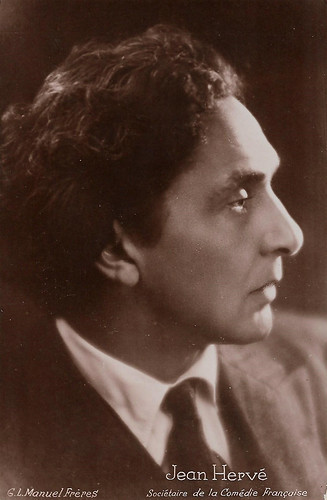
French postcard. Photo: G.L. Manuel Frères. Jean Hervé, Sociétaire de la Comédie Française.
Sources: Ciné-Ressources, Wikiwand, Wikipedia (French), and
For La Terre, see Cinema Europe III, The Other Hollywood, The Music of Light, at YouTube, clip from 3:31-4:52. For Feu Mathias Pascal, the full film is on YouTube. The first scene with Hervé is memorable, see 1:39:08. See also Mathias' imagined strangling of Papiano, from 2:12:33.

French postcard by A.N. (A. Noyer), Paris, no. 38. Photo: G.L. Manuel Frères. Jean Hervé de la Comédie Française.

French postcard in the Nos artistes dans leur loge series, no. 132. Photo: Comoedia.

French postcard, no. 103. On the back, the logo of postcard printer Guilleminot.
A rich film career
Jean Hervé was born in 1884 in Paris.
He made his mark in 1910 with the open air staging of the lyrical tragedy 'Héliogabale' by Déodat de Séverac at the Théâtre des Arènes in Béziers. While Edouard de Max had the lead, and René Alexandre played the hero Rusca who conquers the emperor, Hervé played his friend Claudius. The stage production was accompanied by many ballet acts.
In the early 1910s, Hervé worked for years at the Théâtre de l'Odéon, directed by André Antoine, Firmin Gémier and others. In 1919 he entered the Comédie-Française and between 1925 and 1941, he was Sociétaire there. After 1941 and until the early 1960s he acted at various theatres, in particular at the Théâtre Hébertot and the Odéon.
Jean Hervé also had a rich film career. In 1908 he debuted in the Lux production La fille du braconnier/The poacher's daughter (Gérard Bourgeois, 1908). From 1912 on, he acted in a few Film d'Art films. He was Nero in the Racine adaptation Brittanicus (Camille de Morlhon, 1912), and Bassanio in the William Shakespeare adaption Shylock (Henri Desfontaines, 1913), starring Harry Baur and Pepa Bonafé.
He also acted in the Eclipse production La légende d'Oedipe/Oedipus Rex (Gaston Roudès, 1913), starring Mounet-Sully whose big stage role this had been. At Pathé Frères, Hervé also acted in modern drama: he had the lead in Trente ans ou la vie d'un joueur/Thirty Years of a Gambler's Life (Adrien Caillard, Georges Monca, 1912), about a young husband who falls in the clutches of an evil friend (Georges Tréville), who makes him gamble, wrecks his marriage and almost causes him to kill his own son.
Lacking at IMDb is the Pathé film La Closerie des genêts (Adrien Caillard, 1913), in which he acted opposite Léon Bernard and Sarah Davids, who also acted in the previous film. In 1914 Hervé had a major supporting part in the Pathé episode film Rocambole, shot in 1913 and released in 1914 subsequently as La Jeunesse de Rocambole/Rocambole, Les Exploits de Rocambole/Le Nouveau Rocambole, and Rocambole et l'héritage du marquis de Morfontain. The films were based on the work by Pierre Alexis de Ponson du Terrail, and directed by Georges Denola. While Gaston Silvestre played the title role, Hervé played Armand de Kergaz, Andrée Pascal his wife, Madeleine Céliat was Baccarat, and Tréville co-acted in this film too.

French postcard by MP Moderne, Béziers. Photo: Couture. Jean Hervé in the play 'Héliogabale', directed by Joseph Charry, at the open air Théâtre des Arènes in Béziers on 21 and 23 August 1910.

French postcard. Ballet of the lyrical tragedy 'Héliogabale', on 21 and 23 August 1910 at the Théàtre des Arènes in Béziers. Music was by Déodat de Séverac, Émile Sicard was auteur of the play, while director of the performance was Joseph Charry. Leading actors were Édouard de Max , Madeleine Roch, René Alexandre and Jean Hervé.
Kees van Dongen
After an absence of several years, Jean Hervé returned to the screen in 1920 with - the lost film - Fumée noire/Black Smoke, Louis Delluc's first film, made with his newly founded company Parisia, and co-directed with the more experienced director René Coiffard, who had worked in the US film industry. Star of the film was Eve Francis , Delluc's wife and favourite actress, but Hervé had the male lead.
The plot dealt with a couple of newlyweds whose uncle visits them, back from the Orient. His tales and gifts create dreams that seem to become reality. The production was ambitious, with paintings on the sets painted by Dutch artist Kees van Dongen, then one of the most popular modern artists of Paris.
From then Hervé was back in the picture, acting opposite Pierre Alcover in Le drame des eaux mortes/The drama of the dead waters (Joseph Faivre, 1921), but more important was his part as the evil, ruthless Buteau, harassing his sister's wife Françoise ( Germaine Rouer ) with fatal consequences, in La Terre/The Earth (1921) by André Antoine. Antoine kept Émile Zola's Naturalism by mixing the main actors from the Comédie-Française - who act in a restrained, realist way - with nonprofessionals, and by combining an updated version of 'King Lear' with the picturesque scenery of the French countryside, beautifully cinematographed.
Also released in 1921, were Herve's parts in La vivante épingle/The living pin (Jacques Robert, 1921) and L'étrange aventure du Docteur Works/The Closed Door (Robert Saidreau, 1921). Hervé last role in silent cinema was that of the evil Cavaliere Terenzio Papiano opposite Ivan Mozzhukhin in the title role and Lois Moran as Adriana/Adrienne in the Luigi Pirandello adaptation Feu Mathias Pascal/The Living Dead Man (Marcel L'Herbier, 1926).
Jean Hervé also directed four films ( IMDb only names three): Les deux chemins/The Two Roads (1918) with Manuel Caméré and Juliette Clarens, the Prosper Mérimée adaptation Colomba (1920) starring Mirella Marcovici, Le pauvre village/The poor village (1922) starring Max Maxudian and Germaine Rouer , and shot in Switzerland, and the WWI drama Les deux soldats/The Two Soldiers (1923), for which he also wrote the script.
In the sound era, Hervé mostly played on stage, but he still acted in two more films. He was Talma in Sacha Guitry 's Le destin fabuleux de Désirée Clary/Mlle. Desiree (1942), with Gaby Morlay in the title role, and he had a small role in the Fernandel comedy Adhémar ou le jouet de la fatalité/Adhémar (1951), again by Guitry. Hervé also acted in the TV film Mon coeur est dans les Highlands/My Heart is in the Highlands (Maurice Cazeneuve, 1953) with Roger Hanin .
Jean Hervé died in 1966 in Paris.

French postcard by J.R.P.R., Paris, no. 811. Photo: G.L. Manuel Frères. Jean Hervé de la Comédie Française. In 1925 Hervé became sociétaire at the Comédie Française, so the card may have been from before 1925, after which the handwritten word Sociétaire was added. Card signed by the artist.

French postcard by A.N. Paris, no. 38. Photo: G.L. Manuel Frères. Caption: Jean Hervé de la Comédie Française.

French postcard. Photo: G.L. Manuel Frères. Jean Hervé, Sociétaire de la Comédie Française.
Sources: Ciné-Ressources, Wikiwand, Wikipedia (French), and
For La Terre, see Cinema Europe III, The Other Hollywood, The Music of Light, at YouTube, clip from 3:31-4:52. For Feu Mathias Pascal, the full film is on YouTube. The first scene with Hervé is memorable, see 1:39:08. See also Mathias' imagined strangling of Papiano, from 2:12:33.
Published on March 03, 2020 22:00
March 2, 2020
La déserteuse (1917)
In our 'Spanish Chocolate series', EFSP presents a film special on the Gaumont production La déserteuse/Déserteuse! (Louis Feuillade, 1917). Stars were Yvette Andreyor and René Cresté. Chocolate Pi produced a series of six cards on the film of which the Spanish release title was Tortura de madre.
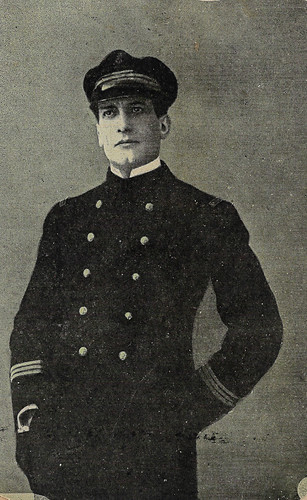
Spanish collectors card by Chocolate Pi, Barcelona, no. 1. Photo: Gaumont. René Cresté in La déserteuse/Déserteuse! (Louis Feuillade, 1917).
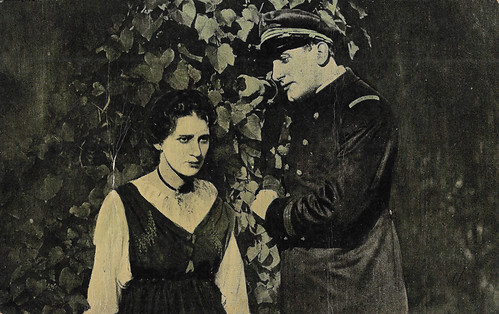
Spanish collectors card by Chocolate Pi, Barcelona, no. 2. Photo: Gaumont. Yvette Andreyor and René Cresté in La déserteuse/Déserteuse! (Louis Feuillade, 1917).
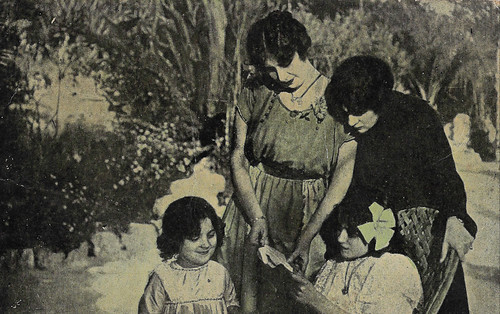
Spanish collectors card by Chocolate Pi, Barcelona, no. 3. Photo: Gaumont. Yvette Andreyor and Olinda Mano in La déserteuse/Déserteuse! (Louis Feuillade, 1917).
Paying her fault with her death
Little is known about La déserteuse/Déserteuse! (Louis Feuillade, 1917), but at the backs of the collectors cards the plot is written. We've translated the Spanish text.
Solange de Gensac ( Yvette Andreyor ) is unhappily married to a man her parents chose. Her only reason for joy is her daughter Lucille ( Olinda Mano ). One day, she is visited by her youth friend, the navy officer Olivier de Esparre ( René Cresté ), whom she once secretly loved. He asks her to reconsider her marriage, but she answers she is still a mother.
However, when one night she sees her husband embracing another woman, she gives Gensac an ultimatum. He laughs it away, so she leaves him with her daughter. Yet, Oliver's work forces him to leave for Peking, so she decides to accompany him. When they are about to take the train though, the child's governess comes alone, as her husband has claimed the child.
Ten years after, Solange and Oliver have returned and live on the Côte d'Azur. Solange's heart has kept bleeding like it did that fatal night on the station. Because of a car accident she is escorted by a governess to a villa of an American couple, who happen to host Lucille. Solange is overjoyed to meet her daughter again, and substitutes as governess to Lucille, but the joy is cut short when the arrival of her ex is announced - so she disappears again in the dark, but not after confessing to Mrs. Davis her tragedy.
Solange gets more and more ill and begs her friend to bring Lucille to her. The husband, though, brutally denies a dying woman her last wish. It is Mrs. Davis, however, who brings Lucille to her dying mother, even if the girl doesn't know who she is. Solange has her last ecstasy seeing her daughter and smelling her flowers. Olivier asks Gensac how he will live on with his guilt, as Solange has paid her fault with her death.
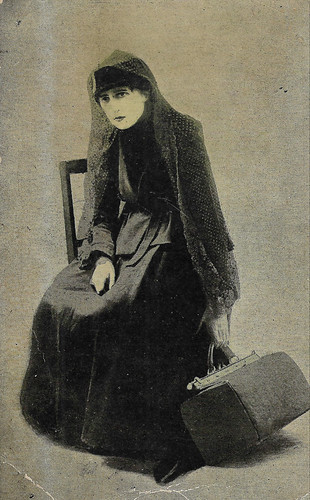
Spanish collectors card by Chocolate Pi, Barcelona, no. 4. Photo: Gaumont. Yvette Andreyor in La déserteuse/Déserteuse! (Louis Feuillade, 1917).
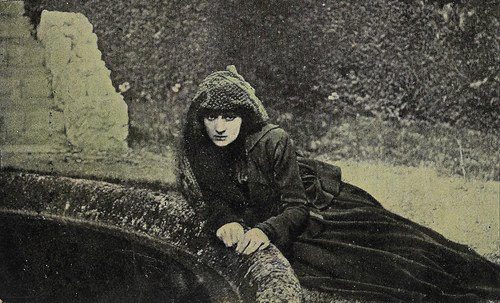
Spanish collectors card by Chocolate Pi, Barcelona, no. 5. Photo: Gaumont. Yvette Andreyor in La déserteuse/Déserteuse! (Louis Feuillade, 1917).
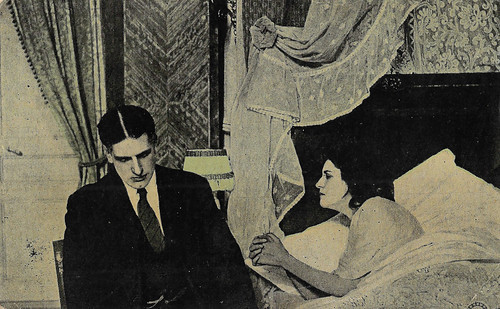
Spanish collectors card by Chocolate Pi, Barcelona, no. 6 (of six cards). Photo: Gaumont. Yvette Andreyor and René Cresté in La déserteuse/Déserteuse! (Louis Feuillade, 1917).
Sources: Wikipedia (French), and IMDb.

Spanish collectors card by Chocolate Pi, Barcelona, no. 1. Photo: Gaumont. René Cresté in La déserteuse/Déserteuse! (Louis Feuillade, 1917).

Spanish collectors card by Chocolate Pi, Barcelona, no. 2. Photo: Gaumont. Yvette Andreyor and René Cresté in La déserteuse/Déserteuse! (Louis Feuillade, 1917).

Spanish collectors card by Chocolate Pi, Barcelona, no. 3. Photo: Gaumont. Yvette Andreyor and Olinda Mano in La déserteuse/Déserteuse! (Louis Feuillade, 1917).
Paying her fault with her death
Little is known about La déserteuse/Déserteuse! (Louis Feuillade, 1917), but at the backs of the collectors cards the plot is written. We've translated the Spanish text.
Solange de Gensac ( Yvette Andreyor ) is unhappily married to a man her parents chose. Her only reason for joy is her daughter Lucille ( Olinda Mano ). One day, she is visited by her youth friend, the navy officer Olivier de Esparre ( René Cresté ), whom she once secretly loved. He asks her to reconsider her marriage, but she answers she is still a mother.
However, when one night she sees her husband embracing another woman, she gives Gensac an ultimatum. He laughs it away, so she leaves him with her daughter. Yet, Oliver's work forces him to leave for Peking, so she decides to accompany him. When they are about to take the train though, the child's governess comes alone, as her husband has claimed the child.
Ten years after, Solange and Oliver have returned and live on the Côte d'Azur. Solange's heart has kept bleeding like it did that fatal night on the station. Because of a car accident she is escorted by a governess to a villa of an American couple, who happen to host Lucille. Solange is overjoyed to meet her daughter again, and substitutes as governess to Lucille, but the joy is cut short when the arrival of her ex is announced - so she disappears again in the dark, but not after confessing to Mrs. Davis her tragedy.
Solange gets more and more ill and begs her friend to bring Lucille to her. The husband, though, brutally denies a dying woman her last wish. It is Mrs. Davis, however, who brings Lucille to her dying mother, even if the girl doesn't know who she is. Solange has her last ecstasy seeing her daughter and smelling her flowers. Olivier asks Gensac how he will live on with his guilt, as Solange has paid her fault with her death.

Spanish collectors card by Chocolate Pi, Barcelona, no. 4. Photo: Gaumont. Yvette Andreyor in La déserteuse/Déserteuse! (Louis Feuillade, 1917).

Spanish collectors card by Chocolate Pi, Barcelona, no. 5. Photo: Gaumont. Yvette Andreyor in La déserteuse/Déserteuse! (Louis Feuillade, 1917).

Spanish collectors card by Chocolate Pi, Barcelona, no. 6 (of six cards). Photo: Gaumont. Yvette Andreyor and René Cresté in La déserteuse/Déserteuse! (Louis Feuillade, 1917).
Sources: Wikipedia (French), and IMDb.
Published on March 02, 2020 22:00
March 1, 2020
Dolly Grey
Dolly Grey aka Dolly Gray (1904-?) was an Italian actress of the silent screen. Her real name was Clara Galassi. Grey acted in Italian and German silent films during the second half of the 1920s. She was film director Guido Brignone's companion after his wife Lola had died in 1924 at the age of only 33. Grey would act in two of his films too. There is little information about Grey and her films, so we did some research in the archives and discovered two mysterious films our usual sources missed.
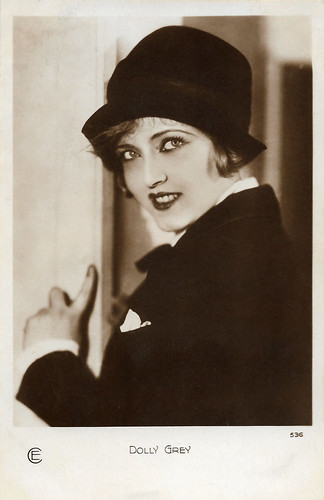
French postcard by Editions Cinémagazine, no. 536.
The Mystery of Caprice de femmes
Dolly Grey was born Clara Galassi in Rome, Italy in 1904.
Her first films were Il focolare spento/The hearth off (Augusto Genina, 1925) with Rina De Liguoro , Lido Manetti and Carmen Boni , and Teodoro e socio/Theodore & Co. (Mario Bonnard, 1925) with Marcel Lévesque .
She then acted in the Italian adventure film Saetta e le sette mogli del Pascià/Pasha's Seven Wives (1926) with Domenico Gambino as Saetta. and in the Dutch film Moderne landhaaien/Modern land sharks (Alex Benno, 1926).
In 1927 she played the paintress Maud opposite Bartolomeo Pagano aka Maciste in Il gigante delle Dolomiti/The giant of the Dolomites (Guido Brignone, 1927), a mountain drama shot at Cortina d'Ampezzo. It was the last in a series of silent films featuring the Peplum hero Maciste. Grey and director Guido Brignone became a couple and went to Germany.
Grey had an uncredited part in Fritz Lang's Metropolis (1927), as one of the female workers. She also had a small part in the Science Fiction film Der Meister der Welt/The master of the world (1927) directed by another Italian émigré in Berlin, Gennaro Righelli, and starring Fred Solm, Xenia Desni , and Olga Tschechova .
According to an announcement in the French magazine Cinéa, and according to the Brignone archive at the Film Museum of Turin, Brignone shot at the Studio des Cicognes the comedy Vite!... Embrassez-moi!.../Quick! ... Kiss me! ... (Guido Brignone, 1927) with Dolly Grey, André Roanne , Luigi Serventi , Berthe Jalabert and many others, but IMDb does not mention the film.
What happened? Was the film never released or is IMDb missing something? The Brignone archive lists a censorship date for Italy, which suggests an Italian release. The newspaper Comoedia had an ad in August 1928, indicating the film was shown at the (Parisian?) cinema Impérial but retitled as Caprice de femmes/Women's caprice and distributed by Franco-Film. The title Caprice de femmes is also absent at IMDb .
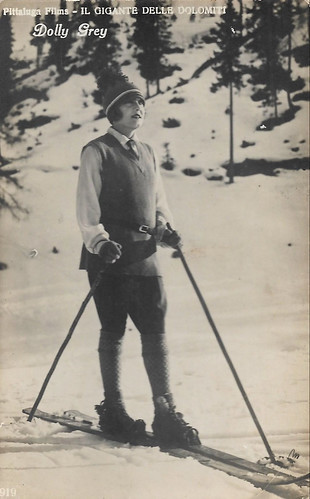
Italian postcard by S.A. Stefano Pittaluga, no. 919. Photo: Pittaluga Films. Dolly Grey in Il gigante delle Dolomiti (Guido Brignone, 1927), starring Bartolomeo Pagano aka Maciste.
Another mystery: Le Retour
Caprice de femmes may not have been a huge success, but Dolly Grey and Guido Brignone were able to make another film, Le Retour/The return (Guido Brignone, 1928), that was apparently co-produced by France and is not mentioned by IMDb . Early announcements indicate that it was a film with Grey, Max Maxudian, André Mattoni and little Cloclo.
Original papers and journals on Gallica (Le Gaullois, la Presse) indicate the film was produced by the Société des Films Artistiques (Sofar) and distributed by Les Films Cosmograph. It must have been the French version or French title of the film listed at IMDb as the German production Marys großes Geheimnis/Mary's big secret (Guido Brignone, 1928), produced by Lothar Stark-Film. Filmportal.de also mentions the film, but under the title Aus dem Elternhaus vertrieben (Guido Brignone, 1927-1928).
The film was partly shot in Berlin (the interiors), partly in Paris (the exteriors). In November 1927, an emotional scene of the film was shot at the Bois de Boulogne, in front of the Parisian press (Figaro, Paris-soir, etc.). In the scene Max Maxudian is about to declare Grey his love, when his grandson Cloclo reminds him that his only love by now should be that of grandfather.
In the same month, Brignone went to Berlin to shoot the interiors at the Efa Studio. Léo Joannon and Adolf Rosen were his assistant-directors, while Gustave Preiss was the cinematographer in France and Akos Farkas (or both) in Germany.
When the film came out in France early 1928, Marcel Lapierre in the socialist journal Le Peuple thought it 'a bit long and ornate', but the critic praised the performances of Grey, Mattoni, Maxudian and little Cloclo. In August 1928, Le Journal praised in particular Maxudian's performance in the film. Le Retour fared better than Caprice de femmes. In 1929, Le Retour was still shown in provincial cinemas in France.
Dolly Grey returned to Berlin for a major part in the German comedy Robert und Bertram/Robert and Bertram (Rudolf Walther-Fein, 1928), featuring Harry Liedtke and Fritz Kampers.
Her last role was in the Italian late silent film Maratona/Marathon (Nicola Fausto Neroni, 1929) with Elio Steiner. The ad of the film at IMDb shows that she was still presented as the main star of the film.
However, we don't know what happened to Dolly Grey after this film nor when or where she died.
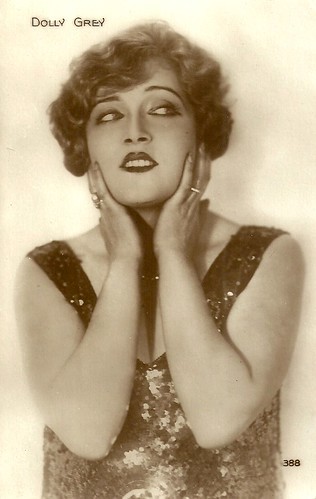
French postcard by Editions Cinémagazine, no. 388.
Sources: , Wikipedia, Filmportal.de, and many original French papers and trade papers at Gallica.

French postcard by Editions Cinémagazine, no. 536.
The Mystery of Caprice de femmes
Dolly Grey was born Clara Galassi in Rome, Italy in 1904.
Her first films were Il focolare spento/The hearth off (Augusto Genina, 1925) with Rina De Liguoro , Lido Manetti and Carmen Boni , and Teodoro e socio/Theodore & Co. (Mario Bonnard, 1925) with Marcel Lévesque .
She then acted in the Italian adventure film Saetta e le sette mogli del Pascià/Pasha's Seven Wives (1926) with Domenico Gambino as Saetta. and in the Dutch film Moderne landhaaien/Modern land sharks (Alex Benno, 1926).
In 1927 she played the paintress Maud opposite Bartolomeo Pagano aka Maciste in Il gigante delle Dolomiti/The giant of the Dolomites (Guido Brignone, 1927), a mountain drama shot at Cortina d'Ampezzo. It was the last in a series of silent films featuring the Peplum hero Maciste. Grey and director Guido Brignone became a couple and went to Germany.
Grey had an uncredited part in Fritz Lang's Metropolis (1927), as one of the female workers. She also had a small part in the Science Fiction film Der Meister der Welt/The master of the world (1927) directed by another Italian émigré in Berlin, Gennaro Righelli, and starring Fred Solm, Xenia Desni , and Olga Tschechova .
According to an announcement in the French magazine Cinéa, and according to the Brignone archive at the Film Museum of Turin, Brignone shot at the Studio des Cicognes the comedy Vite!... Embrassez-moi!.../Quick! ... Kiss me! ... (Guido Brignone, 1927) with Dolly Grey, André Roanne , Luigi Serventi , Berthe Jalabert and many others, but IMDb does not mention the film.
What happened? Was the film never released or is IMDb missing something? The Brignone archive lists a censorship date for Italy, which suggests an Italian release. The newspaper Comoedia had an ad in August 1928, indicating the film was shown at the (Parisian?) cinema Impérial but retitled as Caprice de femmes/Women's caprice and distributed by Franco-Film. The title Caprice de femmes is also absent at IMDb .

Italian postcard by S.A. Stefano Pittaluga, no. 919. Photo: Pittaluga Films. Dolly Grey in Il gigante delle Dolomiti (Guido Brignone, 1927), starring Bartolomeo Pagano aka Maciste.
Another mystery: Le Retour
Caprice de femmes may not have been a huge success, but Dolly Grey and Guido Brignone were able to make another film, Le Retour/The return (Guido Brignone, 1928), that was apparently co-produced by France and is not mentioned by IMDb . Early announcements indicate that it was a film with Grey, Max Maxudian, André Mattoni and little Cloclo.
Original papers and journals on Gallica (Le Gaullois, la Presse) indicate the film was produced by the Société des Films Artistiques (Sofar) and distributed by Les Films Cosmograph. It must have been the French version or French title of the film listed at IMDb as the German production Marys großes Geheimnis/Mary's big secret (Guido Brignone, 1928), produced by Lothar Stark-Film. Filmportal.de also mentions the film, but under the title Aus dem Elternhaus vertrieben (Guido Brignone, 1927-1928).
The film was partly shot in Berlin (the interiors), partly in Paris (the exteriors). In November 1927, an emotional scene of the film was shot at the Bois de Boulogne, in front of the Parisian press (Figaro, Paris-soir, etc.). In the scene Max Maxudian is about to declare Grey his love, when his grandson Cloclo reminds him that his only love by now should be that of grandfather.
In the same month, Brignone went to Berlin to shoot the interiors at the Efa Studio. Léo Joannon and Adolf Rosen were his assistant-directors, while Gustave Preiss was the cinematographer in France and Akos Farkas (or both) in Germany.
When the film came out in France early 1928, Marcel Lapierre in the socialist journal Le Peuple thought it 'a bit long and ornate', but the critic praised the performances of Grey, Mattoni, Maxudian and little Cloclo. In August 1928, Le Journal praised in particular Maxudian's performance in the film. Le Retour fared better than Caprice de femmes. In 1929, Le Retour was still shown in provincial cinemas in France.
Dolly Grey returned to Berlin for a major part in the German comedy Robert und Bertram/Robert and Bertram (Rudolf Walther-Fein, 1928), featuring Harry Liedtke and Fritz Kampers.
Her last role was in the Italian late silent film Maratona/Marathon (Nicola Fausto Neroni, 1929) with Elio Steiner. The ad of the film at IMDb shows that she was still presented as the main star of the film.
However, we don't know what happened to Dolly Grey after this film nor when or where she died.

French postcard by Editions Cinémagazine, no. 388.
Sources: , Wikipedia, Filmportal.de, and many original French papers and trade papers at Gallica.
Published on March 01, 2020 22:00
February 29, 2020
Orlando Bloom
English actor Orlando Bloom (1977) made his breakthrough as Legolas in The Lord of the Rings film series and rose to fame as Will Turner in the Pirates of the Caribbean film series. He established himself as a leading man in Hollywood with roles such as Paris in Troy (2004) and Balian de Ibelin in Kingdom of Heaven (2005). He later reprised his role as Legolas in The Hobbit film series and currently stars in the series Carnival Row (2019–present).
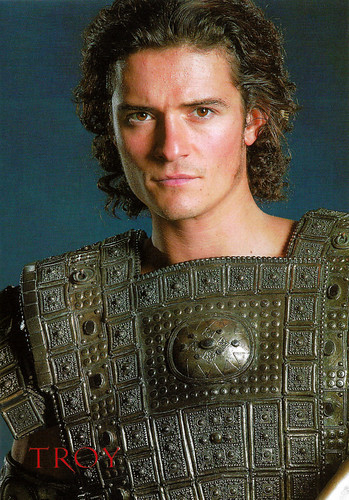
British postcard in the Cinemascope Collections, no. 617. Orlando Bloom in Troy (Wolfgang Petersen, 2004).
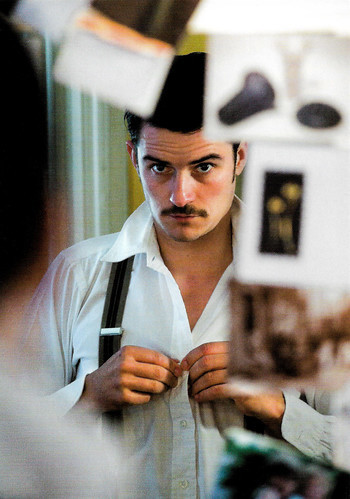
German postcard by Salz und Silber Verlag. Photo: Simon Annand. Caption: Orlando Bloom, Duke of York's Theatre, Celebration, 2007.
Legolas
Orlando Jonathan Blanchard Bloom was born in 1977 in Canterbury, Kent, and was named after the 16th-century English composer Orlando Gibbons. He has an older sister, Samantha Bloom. Orlando initially believed that his biological father was his mother's husband, Harry Bloom, a novelist and political activist who fought for civil rights in South Africa, and who died when Bloom was four years old.
When Orlando was 13, his mother Sonia (Copeland) revealed to him that Colin Stone is actually the biological father of Orlando and his sister; the two were conceived after an agreement by his parents, since Harry, who suffered a stroke in 1975, was unable to have children. Stone, the principal of the Concorde International language school became Orlando's legal guardian after Harry Bloom's death.
Orlando attended St Peter's Methodist Primary School, then the junior school of the King's School before proceeding to St Edmund's School in Canterbury. Bloom was discovered to be dyslexic, and was encouraged by his mother to take art and drama classes. In 1993, the 16-years-old Orlando moved to London to follow a two-year A Level course in Drama, Photography and Sculpture at Fine Arts College, Hampstead.
He then joined the National Youth Theatre, spending two seasons there and earning a scholarship to train at the British American Drama Academy. Bloom began acting professionally with television roles in episodes of Casualty (1997) and Midsomer Murders (1997), and subsequently made his film debut in a small role, as a rent boy, in the critically acclaimed drama Wilde (Brian Gilbert, 1997), opposite Stephen Fry as Oscar Wilde.
Then he entered the Guildhall School of Music and Drama in London, where he studied acting. It was there, in 1998, that Orlando fell three stories from a rooftop terrace and broke his back. Despite fears that he would be permanently paralysed, he quickly recovered and returned to the stage.
Seated in the audience one night in 1999 was a director named Peter Jackson. Two days after graduating from Guildhall in 1999, Bloom was cast as Legolas in The Lord of the Rings film trilogy (Peter Jackson, 2001–2003). He had originally auditioned for the part of Faramir, who does not appear until the second film, but director Peter Jackson cast him as Legolas instead. Legolas made him a household name. At the same time, Bloom also played a brief role in Ridley Scott's war film Black Hawk Down (Ridley Scott, 2001) as PFC Todd Blackburn.
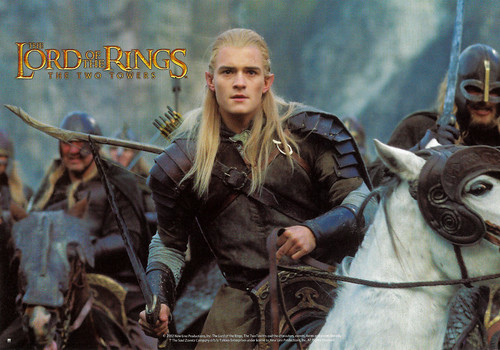
French postcard by Sonis, no. C. 1378. Photo: New Line Productions, Inc. Orlando Bloom in Lord of the Rings - The Two Towers (Peter Jackson, 2002).
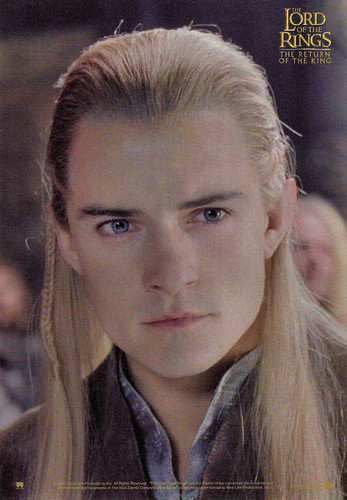
French postcard by Sonis, no. C. 1554. Photo: New Line Productions, Inc. Orlando Bloom in Lord of the Rings - The Return of the King (Peter Jackson, 2003).
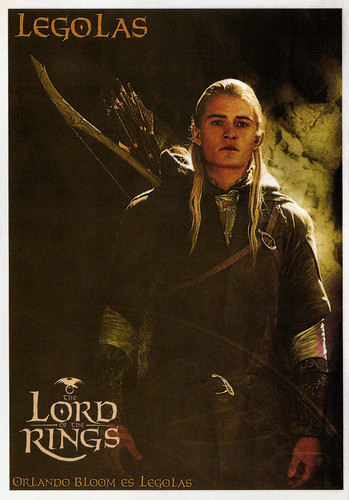
British postcard by Memory Card, no. 744. Photo: Orlando Bloom in Lord of the Rings (Peter Jackson, 2001-2003).
Will Turner
Orlando Bloom next starred opposite Keira Knightley and Johnny Depp in Pirates of the Caribbean: The Curse of the Black Pearl (Gore Verbinski, 2003), which was a blockbuster hit during the summer of 2003.
After the success of Pirates, Bloom next took to the screen as Paris, the man who effectively started the Trojan War, in the blockbuster Troy (Wolfgang Petersen, 2004) opposite Brad Pitt , Eric Bana and Peter O'Toole .
He subsequently played the lead roles in the epic historical drama Kingdom of Heaven (Ridley Scott, 2005) and in the romantic tragicomedy Elizabethtown (Cameron Crowe, 2005) with Kirsten Dunst. He was listed as a potential nominee on both the 2005 and 2006 Razzie Award nominating ballots. He was suggested in the Worst Supporting Actor category on the 2005 ballot for his performance in Troy (2004). And he was suggested again the next year in the Worst Actor category for his performances in Elizabethtown (2005) and Kingdom of Heaven (2005). He failed to receive either nomination.
In 2006, Bloom starred in the sequel Pirates of the Caribbean: Dead Man's Chest (Gore Verbinski, 2006) and he was one of the guest stars in the sitcom Extras, in which he portrayed an exaggeratedly arrogant, narcissistic version of himself who had a great loathing for Johnny Depp , his co-star in Pirates of the Caribbean. Bloom pushed for Extras to go further by making his part unlikable, and contributed to the gag about him admiring Depp out of sheer jealousy, that Depp was far more talented than he was, not to mention rated higher than him on the 'top hottest' charts.
Bloom then again portrayed Will Turner, in Pirates of the Caribbean: At World's End (Gore Verbinski, 2007). Bloom, who had intended to become a stage actor after graduating from the Guildhall School of Music and Drama, had stated that he would like to leave films for a time and instead appear in stage roles. During the summer of 2007 he appeared in a London revival of In Celebration, a play by David Storey. His character was one of three brothers returning home for their parents' 40th wedding anniversary. In 2009, he was one of many stars to appear in the anthology film New York, I Love You (Shunji Iwai, a.o., 2009), which contained 12 short films in one.
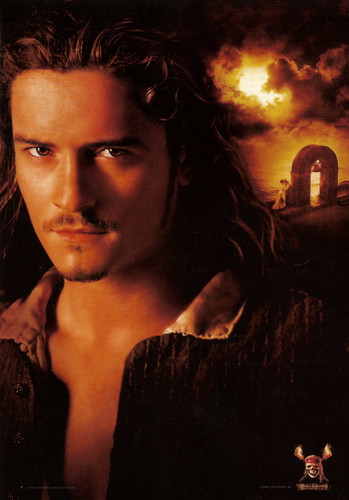
French postcard by Sonis, no. C. 1697. Photo: Disney. Orlando Bloom in Pirates of the Caribbean: Dead Man's Chest (Gore Verbinski, 2006).
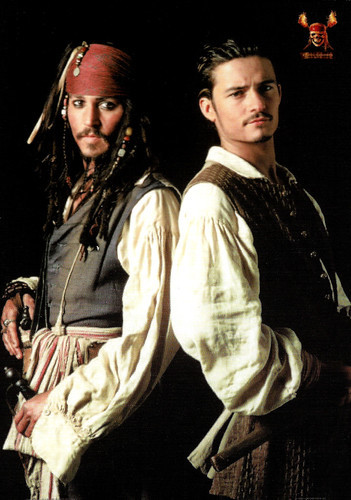
French postcard by Sonis, no. C. 1698. Photo: Disney. Johnny Depp and Orlando Bloom in Pirates of the Caribbean: At World's End (Gore Verbinski, 2007).
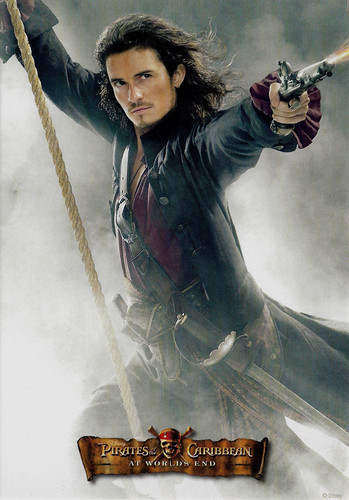
German promotion card by Reinders Posters, no. RPC-15338. Photo: Disney. Orlando Bloom in Pirates of the Caribbean: At World's End (Gore Verbinski, 2007).
Romeo
Orlando Bloom then appeared in The Three Musketeers (Paul W. S. Anderson, 2011) opposite Milla Jovovich, and Christoph Waltz. He reprised his role as Legolas in parts two and three of The Hobbit (Peter Jackson, 2013-2014), the three-part prequel to The Lord of the Rings trilogy.
Bloom made his Broadway stage debut as Romeo in 'Romeo and Juliet' in 2013 at the Richard Rodgers Theatre. The New York Times theatre critic Ben Brantley described Bloom's performance as "a first-rate Broadway debut" in the title role: "For once, we have a Romeo who evolves substantively, from a posturing youth in love with love, to a man who discovers the startling revelation of real love, with a last-act descent into bilious, bitter anger that verges on madness."
Bloom reprised his character, Will Turner, in a supporting role in Pirates of the Caribbean: Dead Men Tell No Tales (Joachim Rønning, Espen Sandberg, 2017). Recently, he starred in the war drama The Outpost (Rod Lurie, 2019), and in the TV show Carnival Row (2019-).
In 2004, Orlando Bloom became a full member of SGI-UK (the UK branch of Soka Gakkai International), a lay Buddhist association affiliated with the teachings of Nichiren. Bloom has also been a part of Global Green, an environmental company, since the early 2000s. Bloom has a tattoo of the Elvish word "nine" on his right wrist, written in fictional Tengwar Elvish script, a reference to his involvement in the Lord of the Rings as one of the nine members of the Fellowship of the Ring. In 2009, Bloom was named a UNICEF Goodwill Ambassador.
Bloom had a relationship with American actress Kate Bosworth, from 2003 till 2006. In late 2007, Bloom began dating Australian supermodel Miranda Kerr. They married the following month in 2010 and Kerr gave birth to their son Flynn Christopher Blanchard Copeland Bloom (2011). The two were divorced in 2013. He is now in a relationship with pop singer Katy Perry.
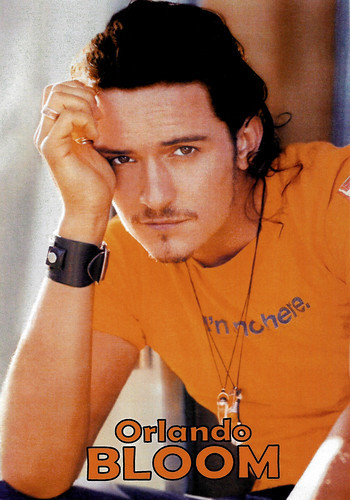
French postcard by Bamba Productions, no. ATHQ 128.
Trailer Carnival Row (2019-). Source: JoBlo Horror Trailers (YouTube).
Sources: (IMDb), Wikipedia and .

British postcard in the Cinemascope Collections, no. 617. Orlando Bloom in Troy (Wolfgang Petersen, 2004).

German postcard by Salz und Silber Verlag. Photo: Simon Annand. Caption: Orlando Bloom, Duke of York's Theatre, Celebration, 2007.
Legolas
Orlando Jonathan Blanchard Bloom was born in 1977 in Canterbury, Kent, and was named after the 16th-century English composer Orlando Gibbons. He has an older sister, Samantha Bloom. Orlando initially believed that his biological father was his mother's husband, Harry Bloom, a novelist and political activist who fought for civil rights in South Africa, and who died when Bloom was four years old.
When Orlando was 13, his mother Sonia (Copeland) revealed to him that Colin Stone is actually the biological father of Orlando and his sister; the two were conceived after an agreement by his parents, since Harry, who suffered a stroke in 1975, was unable to have children. Stone, the principal of the Concorde International language school became Orlando's legal guardian after Harry Bloom's death.
Orlando attended St Peter's Methodist Primary School, then the junior school of the King's School before proceeding to St Edmund's School in Canterbury. Bloom was discovered to be dyslexic, and was encouraged by his mother to take art and drama classes. In 1993, the 16-years-old Orlando moved to London to follow a two-year A Level course in Drama, Photography and Sculpture at Fine Arts College, Hampstead.
He then joined the National Youth Theatre, spending two seasons there and earning a scholarship to train at the British American Drama Academy. Bloom began acting professionally with television roles in episodes of Casualty (1997) and Midsomer Murders (1997), and subsequently made his film debut in a small role, as a rent boy, in the critically acclaimed drama Wilde (Brian Gilbert, 1997), opposite Stephen Fry as Oscar Wilde.
Then he entered the Guildhall School of Music and Drama in London, where he studied acting. It was there, in 1998, that Orlando fell three stories from a rooftop terrace and broke his back. Despite fears that he would be permanently paralysed, he quickly recovered and returned to the stage.
Seated in the audience one night in 1999 was a director named Peter Jackson. Two days after graduating from Guildhall in 1999, Bloom was cast as Legolas in The Lord of the Rings film trilogy (Peter Jackson, 2001–2003). He had originally auditioned for the part of Faramir, who does not appear until the second film, but director Peter Jackson cast him as Legolas instead. Legolas made him a household name. At the same time, Bloom also played a brief role in Ridley Scott's war film Black Hawk Down (Ridley Scott, 2001) as PFC Todd Blackburn.

French postcard by Sonis, no. C. 1378. Photo: New Line Productions, Inc. Orlando Bloom in Lord of the Rings - The Two Towers (Peter Jackson, 2002).

French postcard by Sonis, no. C. 1554. Photo: New Line Productions, Inc. Orlando Bloom in Lord of the Rings - The Return of the King (Peter Jackson, 2003).

British postcard by Memory Card, no. 744. Photo: Orlando Bloom in Lord of the Rings (Peter Jackson, 2001-2003).
Will Turner
Orlando Bloom next starred opposite Keira Knightley and Johnny Depp in Pirates of the Caribbean: The Curse of the Black Pearl (Gore Verbinski, 2003), which was a blockbuster hit during the summer of 2003.
After the success of Pirates, Bloom next took to the screen as Paris, the man who effectively started the Trojan War, in the blockbuster Troy (Wolfgang Petersen, 2004) opposite Brad Pitt , Eric Bana and Peter O'Toole .
He subsequently played the lead roles in the epic historical drama Kingdom of Heaven (Ridley Scott, 2005) and in the romantic tragicomedy Elizabethtown (Cameron Crowe, 2005) with Kirsten Dunst. He was listed as a potential nominee on both the 2005 and 2006 Razzie Award nominating ballots. He was suggested in the Worst Supporting Actor category on the 2005 ballot for his performance in Troy (2004). And he was suggested again the next year in the Worst Actor category for his performances in Elizabethtown (2005) and Kingdom of Heaven (2005). He failed to receive either nomination.
In 2006, Bloom starred in the sequel Pirates of the Caribbean: Dead Man's Chest (Gore Verbinski, 2006) and he was one of the guest stars in the sitcom Extras, in which he portrayed an exaggeratedly arrogant, narcissistic version of himself who had a great loathing for Johnny Depp , his co-star in Pirates of the Caribbean. Bloom pushed for Extras to go further by making his part unlikable, and contributed to the gag about him admiring Depp out of sheer jealousy, that Depp was far more talented than he was, not to mention rated higher than him on the 'top hottest' charts.
Bloom then again portrayed Will Turner, in Pirates of the Caribbean: At World's End (Gore Verbinski, 2007). Bloom, who had intended to become a stage actor after graduating from the Guildhall School of Music and Drama, had stated that he would like to leave films for a time and instead appear in stage roles. During the summer of 2007 he appeared in a London revival of In Celebration, a play by David Storey. His character was one of three brothers returning home for their parents' 40th wedding anniversary. In 2009, he was one of many stars to appear in the anthology film New York, I Love You (Shunji Iwai, a.o., 2009), which contained 12 short films in one.

French postcard by Sonis, no. C. 1697. Photo: Disney. Orlando Bloom in Pirates of the Caribbean: Dead Man's Chest (Gore Verbinski, 2006).

French postcard by Sonis, no. C. 1698. Photo: Disney. Johnny Depp and Orlando Bloom in Pirates of the Caribbean: At World's End (Gore Verbinski, 2007).

German promotion card by Reinders Posters, no. RPC-15338. Photo: Disney. Orlando Bloom in Pirates of the Caribbean: At World's End (Gore Verbinski, 2007).
Romeo
Orlando Bloom then appeared in The Three Musketeers (Paul W. S. Anderson, 2011) opposite Milla Jovovich, and Christoph Waltz. He reprised his role as Legolas in parts two and three of The Hobbit (Peter Jackson, 2013-2014), the three-part prequel to The Lord of the Rings trilogy.
Bloom made his Broadway stage debut as Romeo in 'Romeo and Juliet' in 2013 at the Richard Rodgers Theatre. The New York Times theatre critic Ben Brantley described Bloom's performance as "a first-rate Broadway debut" in the title role: "For once, we have a Romeo who evolves substantively, from a posturing youth in love with love, to a man who discovers the startling revelation of real love, with a last-act descent into bilious, bitter anger that verges on madness."
Bloom reprised his character, Will Turner, in a supporting role in Pirates of the Caribbean: Dead Men Tell No Tales (Joachim Rønning, Espen Sandberg, 2017). Recently, he starred in the war drama The Outpost (Rod Lurie, 2019), and in the TV show Carnival Row (2019-).
In 2004, Orlando Bloom became a full member of SGI-UK (the UK branch of Soka Gakkai International), a lay Buddhist association affiliated with the teachings of Nichiren. Bloom has also been a part of Global Green, an environmental company, since the early 2000s. Bloom has a tattoo of the Elvish word "nine" on his right wrist, written in fictional Tengwar Elvish script, a reference to his involvement in the Lord of the Rings as one of the nine members of the Fellowship of the Ring. In 2009, Bloom was named a UNICEF Goodwill Ambassador.
Bloom had a relationship with American actress Kate Bosworth, from 2003 till 2006. In late 2007, Bloom began dating Australian supermodel Miranda Kerr. They married the following month in 2010 and Kerr gave birth to their son Flynn Christopher Blanchard Copeland Bloom (2011). The two were divorced in 2013. He is now in a relationship with pop singer Katy Perry.

French postcard by Bamba Productions, no. ATHQ 128.
Trailer Carnival Row (2019-). Source: JoBlo Horror Trailers (YouTube).
Sources: (IMDb), Wikipedia and .
Published on February 29, 2020 22:00
February 28, 2020
New acquisitions: Éditions Sid
Editions Sid was a French publisher that was active in the 1910s and 1920s. During the First World War, Sid was particularly active in making postcards. Their cards took the war lightly and with humour, and created a link between the combatants and those left at home. Sid also released cartoonesque cards by illustrators such as Mich and Gibson, that contained English and French captions at the same time. The series with portraits by G.L. Manuel Frères of female stars from stage and screen must date from the early 1920s, as some of the ladies depicted where only popular then. Pearl White seems to be the only non-French star in the series. Then again, her serials were massively popular in France in the late 1910s and early 1920s, and were mostly produced by the American branch of the French company Pathé.
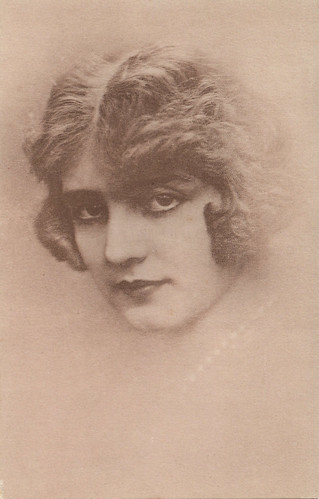
French postcard by Éditions Sid, Paris, no. 8025. Photo: G.L. Manuel Frères.
Solange (de) Vlaminck was a French actress, known for the silent films La vierge du portail (1923) and Bénitou (1922). She was the younger sister (or daughter?) of painter Maurice de Vlaminck.
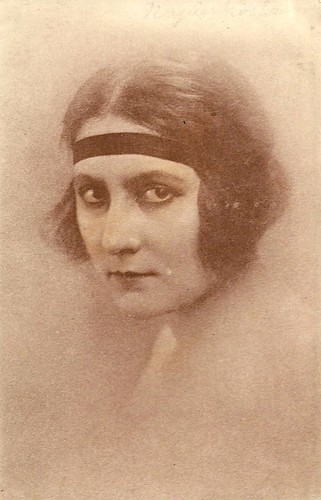
French postcard by Éditions Sid, Paris, no. 8028. Photo G.L. Manuel Frères.
Exotic Stacia Napierkowska (1886-1945) was a fascinating star of the silent film era. The French actress and dancer is best remembered as the seductive but cruel Queen Antinéa in the classic fantasy L’Atlantide/Queen of Atlantis (Jacques Feyder, 1921). Between 1908 and 1926 she appeared in 86 films.
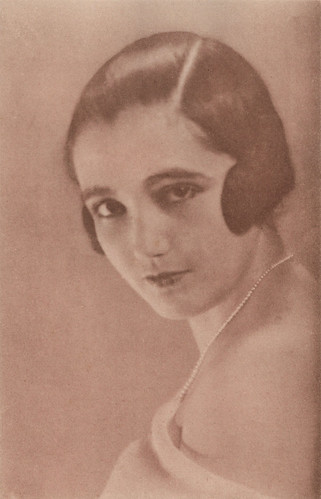
French postcard by Éditions Sid, Paris, no. 8029. Photo G.L. Manuel Frères.
Grace Ovide was a French dancer, who, with her partner, Street, in the early 1920s performed at the Olympia in Paris and other French venues such as the Hotel Rühl in Nice, frequented by Americans, and the Carlton Hotel in Biarritz. It seems Ovide didn't perform in films.
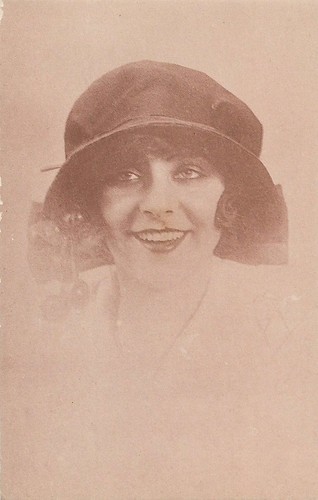
French postcard by Éditions Sid, Paris, no. 8030. Photo G.L. Manuel Frères.
French singer and actress Yvonne Printemps (1894-1977) was a huge star of the European stage. She also appeared in ten international silent and sound films. A true diva, she loved the spotlight, and would be seen draped with jewels, wearing enormous hats and having her pet dogs on a leash.
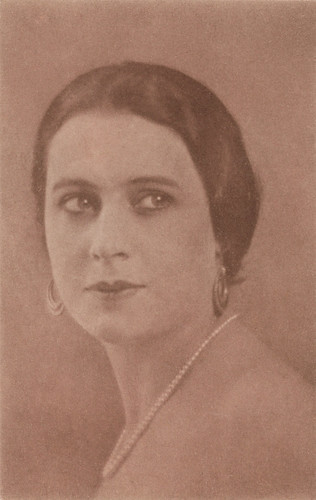
French postcard by Éditions Sid, Paris, no. 8032. Photo: G.L. Manuel Frères.
Blond Paulette Duval (1889-1951) was a French dancer and actress of the silent cinema and early sound films. She was considered one of the most beautiful women in Paris and made her film debut in France in 1920. From 1921 on, she appeared in Hollywood films for Fox, Paramount, M.G.M and Columbia. Best known is her role as Madame de Pompadour in Monsieur Beaucaire (1923), starring Rudolph Valentino .
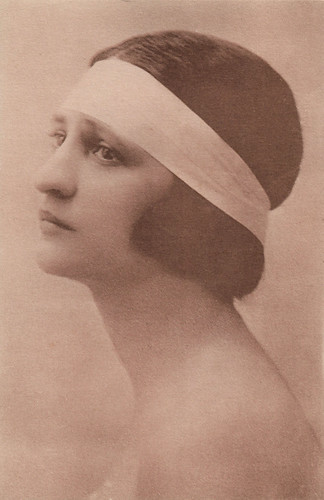
French postcard by Éditions Sid, Paris, no. 8033. Photo: G.L. Manuel Frères.
Camille Bos (born 1899) was a French ballet dancer. At the age of 10 (other sources say: 8), she entered the ballet school of the Paris Opera. In 1920 she was named 'première danseuse', and in 1925 she was promoted to 'danseuse étoile' (star dancer). Bos participated in numerous performances e.g. 'Siang-Sin' (1927), 'L'écran des jeunes filles' (1929), 'La Grisi' (choreography by Albert d'Aveline, 1935), etc. Her partners were among the famous dancers of those decades such as Serge Peretti and Serge Lifar with whom she danced in 'Le Spectre de la Rose' (1931) by Michel Fokine. At the age of 36, Bos stopped dancing to dedicate herself to teaching. For 12 years, she taught at the Opéra de Paris. Her only known film performance was as a dancer in the Zola adaptation Nantas (Donatien, 1925) and starring Donatien , Lucienne Legrand, and Maxime Desjardins . In 1935 she was recorded for an early television experiment.
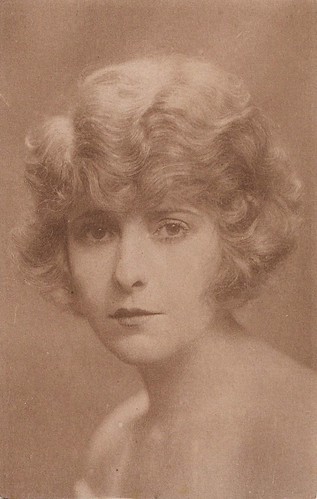
French postcard by Éditions Sid, Paris, no. 8035. Photo: G.L. Manuel Frères.
American actress Pearl White (1889-1938) was dubbed 'Queen of the Serials'. She was noted for doing her own stunts in silent film serials such as The Perils of Pauline (1914) and The Exploits of Elaine (1914-1915). Many episodes ended with a literal cliffhanger. In Europe, The Exploits of Elaine were re-edited with two subsequent serials into Les Mystères de New York. Until the end of the First World War, White remained a globally popular action heroine.
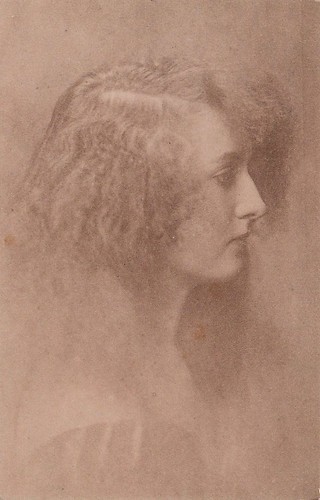
French postcard by Éditions Sid, Paris, no. 8037. Photo: G.L. Manuel Frères.
Agnès Souret is a French actress, who appeared in the silent films Le Lys du Mont Saint-Michel/The lily of Mont Saint-Michel (Henry Houry, J. Sheffer, 1920), La Maison des pendus/The house of the hanged (Henry Houry, 1921) and La Tournée Farigoule/The Farigoule Tour (Marcel Manchez, 1926).
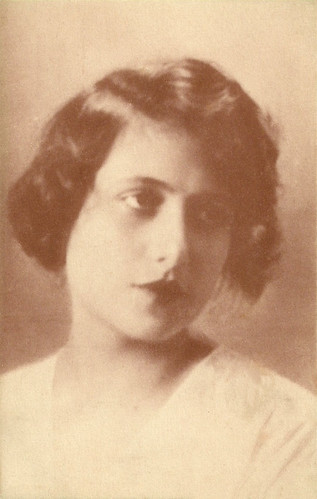
French postcard by Editions Sid, Paris, no. 8038. Photo: G.L. Manuel Frères.
Renée Falconetti (1892-1946), aka Maria Falconetti and simply Falconetti, was a French actress. Though she had a long stage career, and played in two other silent films, she is best known for her major performance in Carl Dreyer’s silent film La passion de Jeanne d’Arc (1928).
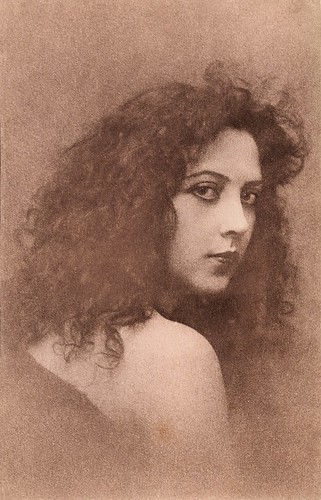
French postcard by Editions Sid, Paris, no. 8039. Photo: G.L. Manuel Frères.
With her heavily kohled dark eyes, somewhat sinister make-up, pale skin and exotic wardrobes, French actress Musidora (1889-1957) created an unforgettable vamp persona. She is best known for her roles in the Louis Feuillade serials Les Vampires (1915-1916) as Irma Vep, the voluptuous, amoral villainess, and in Judex (1917) as Marie Verdier. At a time when many women in the film industry were relegated to acting, Musidora also achieved some success as a producer and director. Later she became a journalist and wrote about cinema.
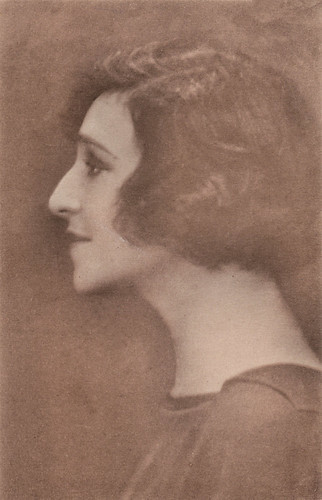
French postcard by Editions Sid, no. 8041. Photo: G.L. Manuel Frères, Paris.
Marie or Maria Ventura (1888-1954) was a Romanian-French actress and theatre director. She became well known in the silent cinema with her role in the popular serial Les misérables (Albert Capellani, 1912). From 1919 to 1941 she worked at the Comédie-Française. In 1938, she directed 'Iphigénie' by Racine, becoming the first women to direct a play at the Comédie-Française.
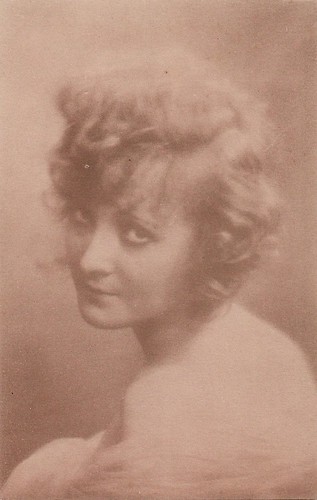
French postcard by Éditions Sid, Paris, no. 8044. Photo: G.L. Manuel Frères.
Irène Wells was a French stage and screen actress, known for the serial La bâillonnée/The gagged (Charles Burguet, 1922), the comedy Ma tante d'Honfleur/My aunt of Honfleur (Robert Saidreau, 1923), Quelqu'un dans l'ombre/Someone in the shadows (Marcel Manchez, 1924), and Phi-Phi (Georges Pallu, 1927).
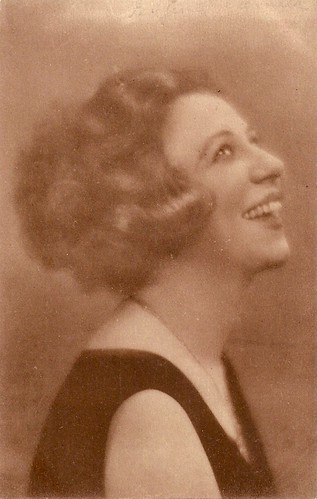
French postcard by Éditions Sid, Paris, no. 8045. Photo: G.L. Manuel Frères.
Régina Camier (1894-?) was a French stage and screen actress. It is clear she had a rich theatre career in the 1920s and 1930s, in plays by Crommlynck and Duvernois. At one stage, she even owned a theatre and she also directed two operettas in the 1920s. Yet, it is unclear how much films she did. Cine-Ressources indicates only a small part in Par la vérité (Gaston Leprieur, Maurice de Féraudy, 1917). The BFI indicates she is also visible in a British Gaumont newsreel of 1922, Around the Town No. 110. Camier was married to Léon Deutsch (1892-1982), who built the Théâtre des Nouveautés in 1920.
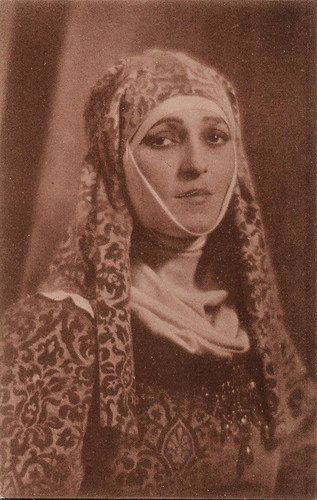
French postcard by Editions Sid, Paris, no. 8046. Photo: G.L. Manuel Frères. The costume on the card refers to a stage play set in the Middle Ages or the Renaissance, but it is unclear which one.
Marie or Maria Ventura (1888-1954) was a Romanian-French actress and theatre director. She became well known in the silent cinema with her role in the popular serial Les misérables (Albert Capellani, 1912). From 1919 to 1941 she worked at the Comédie-Française. In 1938, she directed 'Iphigénie' by Racine, becoming the first women to direct a play at the Comédie-Française.
For more photos by G.L Manuel Frères check out our 2015 post.
Sources: , Wikipedia (French), BnF and Delcampe.

French postcard by Éditions Sid, Paris, no. 8025. Photo: G.L. Manuel Frères.
Solange (de) Vlaminck was a French actress, known for the silent films La vierge du portail (1923) and Bénitou (1922). She was the younger sister (or daughter?) of painter Maurice de Vlaminck.

French postcard by Éditions Sid, Paris, no. 8028. Photo G.L. Manuel Frères.
Exotic Stacia Napierkowska (1886-1945) was a fascinating star of the silent film era. The French actress and dancer is best remembered as the seductive but cruel Queen Antinéa in the classic fantasy L’Atlantide/Queen of Atlantis (Jacques Feyder, 1921). Between 1908 and 1926 she appeared in 86 films.

French postcard by Éditions Sid, Paris, no. 8029. Photo G.L. Manuel Frères.
Grace Ovide was a French dancer, who, with her partner, Street, in the early 1920s performed at the Olympia in Paris and other French venues such as the Hotel Rühl in Nice, frequented by Americans, and the Carlton Hotel in Biarritz. It seems Ovide didn't perform in films.

French postcard by Éditions Sid, Paris, no. 8030. Photo G.L. Manuel Frères.
French singer and actress Yvonne Printemps (1894-1977) was a huge star of the European stage. She also appeared in ten international silent and sound films. A true diva, she loved the spotlight, and would be seen draped with jewels, wearing enormous hats and having her pet dogs on a leash.

French postcard by Éditions Sid, Paris, no. 8032. Photo: G.L. Manuel Frères.
Blond Paulette Duval (1889-1951) was a French dancer and actress of the silent cinema and early sound films. She was considered one of the most beautiful women in Paris and made her film debut in France in 1920. From 1921 on, she appeared in Hollywood films for Fox, Paramount, M.G.M and Columbia. Best known is her role as Madame de Pompadour in Monsieur Beaucaire (1923), starring Rudolph Valentino .

French postcard by Éditions Sid, Paris, no. 8033. Photo: G.L. Manuel Frères.
Camille Bos (born 1899) was a French ballet dancer. At the age of 10 (other sources say: 8), she entered the ballet school of the Paris Opera. In 1920 she was named 'première danseuse', and in 1925 she was promoted to 'danseuse étoile' (star dancer). Bos participated in numerous performances e.g. 'Siang-Sin' (1927), 'L'écran des jeunes filles' (1929), 'La Grisi' (choreography by Albert d'Aveline, 1935), etc. Her partners were among the famous dancers of those decades such as Serge Peretti and Serge Lifar with whom she danced in 'Le Spectre de la Rose' (1931) by Michel Fokine. At the age of 36, Bos stopped dancing to dedicate herself to teaching. For 12 years, she taught at the Opéra de Paris. Her only known film performance was as a dancer in the Zola adaptation Nantas (Donatien, 1925) and starring Donatien , Lucienne Legrand, and Maxime Desjardins . In 1935 she was recorded for an early television experiment.

French postcard by Éditions Sid, Paris, no. 8035. Photo: G.L. Manuel Frères.
American actress Pearl White (1889-1938) was dubbed 'Queen of the Serials'. She was noted for doing her own stunts in silent film serials such as The Perils of Pauline (1914) and The Exploits of Elaine (1914-1915). Many episodes ended with a literal cliffhanger. In Europe, The Exploits of Elaine were re-edited with two subsequent serials into Les Mystères de New York. Until the end of the First World War, White remained a globally popular action heroine.

French postcard by Éditions Sid, Paris, no. 8037. Photo: G.L. Manuel Frères.
Agnès Souret is a French actress, who appeared in the silent films Le Lys du Mont Saint-Michel/The lily of Mont Saint-Michel (Henry Houry, J. Sheffer, 1920), La Maison des pendus/The house of the hanged (Henry Houry, 1921) and La Tournée Farigoule/The Farigoule Tour (Marcel Manchez, 1926).

French postcard by Editions Sid, Paris, no. 8038. Photo: G.L. Manuel Frères.
Renée Falconetti (1892-1946), aka Maria Falconetti and simply Falconetti, was a French actress. Though she had a long stage career, and played in two other silent films, she is best known for her major performance in Carl Dreyer’s silent film La passion de Jeanne d’Arc (1928).

French postcard by Editions Sid, Paris, no. 8039. Photo: G.L. Manuel Frères.
With her heavily kohled dark eyes, somewhat sinister make-up, pale skin and exotic wardrobes, French actress Musidora (1889-1957) created an unforgettable vamp persona. She is best known for her roles in the Louis Feuillade serials Les Vampires (1915-1916) as Irma Vep, the voluptuous, amoral villainess, and in Judex (1917) as Marie Verdier. At a time when many women in the film industry were relegated to acting, Musidora also achieved some success as a producer and director. Later she became a journalist and wrote about cinema.

French postcard by Editions Sid, no. 8041. Photo: G.L. Manuel Frères, Paris.
Marie or Maria Ventura (1888-1954) was a Romanian-French actress and theatre director. She became well known in the silent cinema with her role in the popular serial Les misérables (Albert Capellani, 1912). From 1919 to 1941 she worked at the Comédie-Française. In 1938, she directed 'Iphigénie' by Racine, becoming the first women to direct a play at the Comédie-Française.

French postcard by Éditions Sid, Paris, no. 8044. Photo: G.L. Manuel Frères.
Irène Wells was a French stage and screen actress, known for the serial La bâillonnée/The gagged (Charles Burguet, 1922), the comedy Ma tante d'Honfleur/My aunt of Honfleur (Robert Saidreau, 1923), Quelqu'un dans l'ombre/Someone in the shadows (Marcel Manchez, 1924), and Phi-Phi (Georges Pallu, 1927).

French postcard by Éditions Sid, Paris, no. 8045. Photo: G.L. Manuel Frères.
Régina Camier (1894-?) was a French stage and screen actress. It is clear she had a rich theatre career in the 1920s and 1930s, in plays by Crommlynck and Duvernois. At one stage, she even owned a theatre and she also directed two operettas in the 1920s. Yet, it is unclear how much films she did. Cine-Ressources indicates only a small part in Par la vérité (Gaston Leprieur, Maurice de Féraudy, 1917). The BFI indicates she is also visible in a British Gaumont newsreel of 1922, Around the Town No. 110. Camier was married to Léon Deutsch (1892-1982), who built the Théâtre des Nouveautés in 1920.

French postcard by Editions Sid, Paris, no. 8046. Photo: G.L. Manuel Frères. The costume on the card refers to a stage play set in the Middle Ages or the Renaissance, but it is unclear which one.
Marie or Maria Ventura (1888-1954) was a Romanian-French actress and theatre director. She became well known in the silent cinema with her role in the popular serial Les misérables (Albert Capellani, 1912). From 1919 to 1941 she worked at the Comédie-Française. In 1938, she directed 'Iphigénie' by Racine, becoming the first women to direct a play at the Comédie-Française.
For more photos by G.L Manuel Frères check out our 2015 post.
Sources: , Wikipedia (French), BnF and Delcampe.
Published on February 28, 2020 22:00
February 27, 2020
Barbara Laage
French actress Barbara Laage (1920-1988) was a popular leading lady in French and American films during the 1950s. Her breakthrough role was the prostitute Lizzie in La Putain Respectueuse/The Respectful Prostitute (1952), based on the play by Sartre.
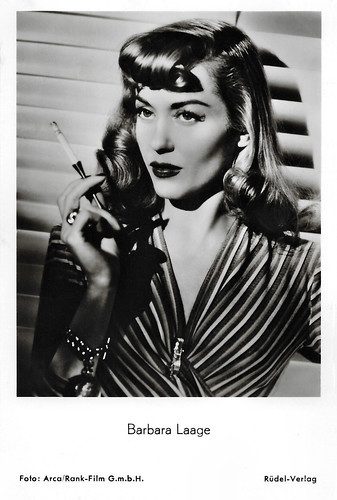
German postcard by Rüdel-Verlag, Hamburg-Bergedorf, no. 489. Photo: Arca / Rank-film G.m.b.H. Barbara Laage in La putain respectueuse/The Respectful Prostitute (Charles Brabant, Marcello Pagliero, 1952).
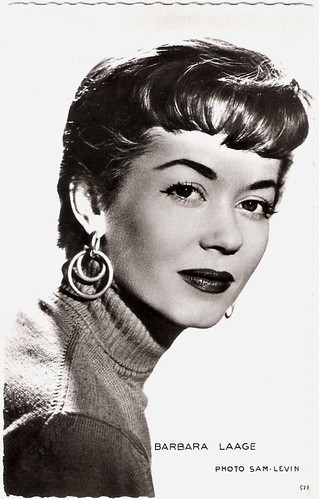
French postcard by Editions P.I., Paris, no. 528, presented by Les Carbones Korès 'Carboplane'. Photo: Sam Lévin.
Prostitute
Barbara Laage was born as Janine Antoinette Laage in the small village of Menthon-Saint-Bernard, at the banks of Lac d’Annecy in France in 1920. Wikipedia and IMDb suggest that her real name was Claire Colombat.
At the end of the 1930s Laage followed acting classes from Raymond Rouleau , and interpreted the classical plays.
She made her film debut as an extra in Signé illisible/Signed unreadable (Christian Chamborant, 1942). After WWII, she performed in theatres and nightclubs in Paris.
Noticed by a photographer of the American magazine Life in 1946, she left for Hollywood where she was approached for the title role in The Lady from Shanghai (Orson Welles, 1947). Some sources say that the script was even originally written for her. However, Orson Welles decided to cast his then-wife Rita Hayworth in the part.
Laage made her American film debut in a secondary role in B.F.'s Daughter (Robert Z. Leonard, 1948) as the Dutch girlfriend of Van Heflin.
She then returned to France, where she appeared in La rose rouge/The Red Rose (Marcello Pagliero, 1951) with Françoise Arnoul .
Her breakthrough role was the prostitute Lizzie in La Putain Respectueuse/The Respectful Prostitute(Charles Brabant, Marcello Pagliero, 1952), an adaptation of the play by Jean-Paul Sartre.
D.B. DuMonteil in his IMDb review: "Brabant/Pagliero's film is faithful to the writer's play. It sure was not easy to locate the story in America, to find an actress in the Gloria Grahame mold and to recreate the riots and the atmosphere of America but they manage quite well. Barbara Laage is convincing and her last scene with the unfortunate black young man very moving. No exit indeed. It's quite possible that Sartre's story was inspired by black writer Richard Wright who took refuge in France."
In the following decade, Laage mixed roles in American films like Act of Love/Un acte d’amour (Anatole Litvak, 1953) opposite Kirk Douglas , and The Happy Road (Gene Kelly, 1956) starring Gene Kelly himself, with parts in French films such as L’esclave/The Slave (Yves Ciampi, 1953) with Daniel Gélin , and the spy thriller Action immédiate/Immediate Action (Maurice Labro, 1957) opposite Henri Vidal .
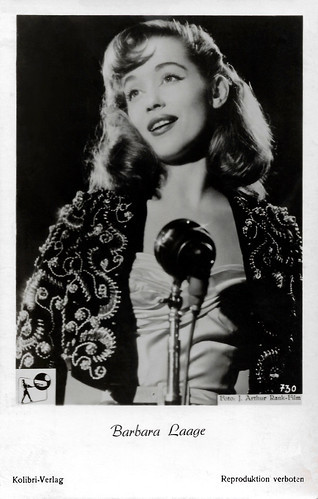
German postcard by Kolibri-Verlag. Photo: Rank-film G.m.b.H. Barbara Laage in La putain respectueuse/The Respectful Prostitute (Charles Brabant, Marcello Pagliero, 1952).
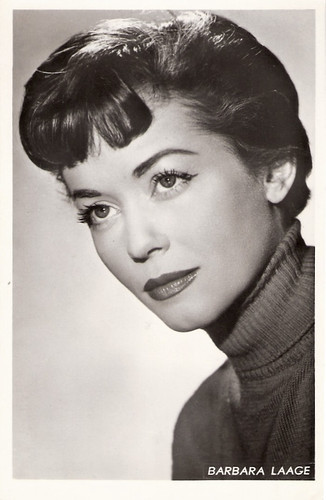
Dutch postcard by Takken, no. AX 1940.
Erotic Cult Movie
During the 1960s, Barbara Laage appeared in several international but mediocre productions. In Germany she played in Orientalische Nächte/Oriental Nights (Heinz Paul, 1960) with Pero Alexander , and Bomben auf Monte Carlo/Bombs on Monte Carlo (Georg Jacoby, 1960) opposite Eddie Constantine .
In France she starred in the comedy Le Caïd/The Boss (Bernard Borderie, 1960) opposite Fernandel , and in Vacances portugaises/Portuguese Vacation (Pierre Kast, 1963) with Françoise Arnoul . In Portugal she appeared in O Crime da Aldeia Velha (Manuel Guimarães, 1964).
Interesting were Paris Blues (Martin Ritt, 1961) in which she played a secondary part next to Paul Newman and Joanne Woodward, and the erotic cult movie Therese and Isabelle (Radley Metzger, 1968), based on the lesbian-themed novel by Violette Leduc. In the film she played the mother of Therese (Essy Persson).
In the fourth installment of the great Antoine Doinel film series, Domicile Conjugale/Bed & Board (François Truffaut, 1970), she played Jean-Pierre Léaud ’s colleague with whom he has an affair.
During the 1970s, Barbara Laage appeared mainly on television. Among her few theatrical films in this period were Défense de savoir/Forbidden To Know (Nadine Trintignant, 1973) with Jean-Louis Trintignant , and Projection privée/Private Projection (François Leterrier, 1973) with Jane Birkin and Bulle Ogier.
Barbara Laage played her last screen part in the TV-film Une place forte/A Strong Place (Guy Jorré, 1976) with Ivan Desny , her co-star from La Putain Respectueuse/The Respectful Prostitute (1952).
She retired and during her last 12 years she lived with her sister in Deauville in Normandy, where she died in 1988. During her life she had relationships with Olympic ski champion Guy de Huertas and assistant director Noël Howard.
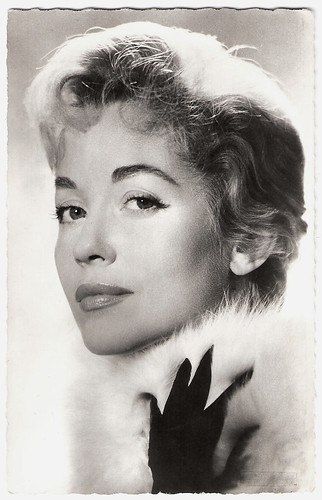
French postcard by Editions du Globe, Paris, no. 630. Photo: Lucienne Chevert.
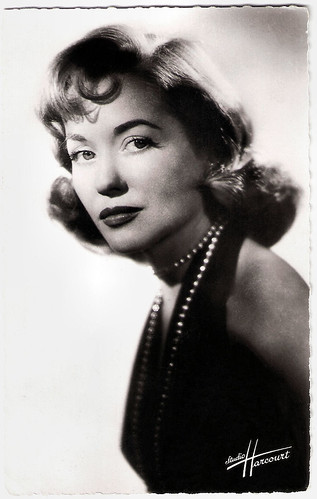
French postcard by Editions du Globe, no. 278. Photo: Studio Harcourt.
Sources: Caroline Hanotte (CinéArtistes - French),
Wikipedia (German), Sandra Brennan (AllMovie) and .

German postcard by Rüdel-Verlag, Hamburg-Bergedorf, no. 489. Photo: Arca / Rank-film G.m.b.H. Barbara Laage in La putain respectueuse/The Respectful Prostitute (Charles Brabant, Marcello Pagliero, 1952).

French postcard by Editions P.I., Paris, no. 528, presented by Les Carbones Korès 'Carboplane'. Photo: Sam Lévin.
Prostitute
Barbara Laage was born as Janine Antoinette Laage in the small village of Menthon-Saint-Bernard, at the banks of Lac d’Annecy in France in 1920. Wikipedia and IMDb suggest that her real name was Claire Colombat.
At the end of the 1930s Laage followed acting classes from Raymond Rouleau , and interpreted the classical plays.
She made her film debut as an extra in Signé illisible/Signed unreadable (Christian Chamborant, 1942). After WWII, she performed in theatres and nightclubs in Paris.
Noticed by a photographer of the American magazine Life in 1946, she left for Hollywood where she was approached for the title role in The Lady from Shanghai (Orson Welles, 1947). Some sources say that the script was even originally written for her. However, Orson Welles decided to cast his then-wife Rita Hayworth in the part.
Laage made her American film debut in a secondary role in B.F.'s Daughter (Robert Z. Leonard, 1948) as the Dutch girlfriend of Van Heflin.
She then returned to France, where she appeared in La rose rouge/The Red Rose (Marcello Pagliero, 1951) with Françoise Arnoul .
Her breakthrough role was the prostitute Lizzie in La Putain Respectueuse/The Respectful Prostitute(Charles Brabant, Marcello Pagliero, 1952), an adaptation of the play by Jean-Paul Sartre.
D.B. DuMonteil in his IMDb review: "Brabant/Pagliero's film is faithful to the writer's play. It sure was not easy to locate the story in America, to find an actress in the Gloria Grahame mold and to recreate the riots and the atmosphere of America but they manage quite well. Barbara Laage is convincing and her last scene with the unfortunate black young man very moving. No exit indeed. It's quite possible that Sartre's story was inspired by black writer Richard Wright who took refuge in France."
In the following decade, Laage mixed roles in American films like Act of Love/Un acte d’amour (Anatole Litvak, 1953) opposite Kirk Douglas , and The Happy Road (Gene Kelly, 1956) starring Gene Kelly himself, with parts in French films such as L’esclave/The Slave (Yves Ciampi, 1953) with Daniel Gélin , and the spy thriller Action immédiate/Immediate Action (Maurice Labro, 1957) opposite Henri Vidal .

German postcard by Kolibri-Verlag. Photo: Rank-film G.m.b.H. Barbara Laage in La putain respectueuse/The Respectful Prostitute (Charles Brabant, Marcello Pagliero, 1952).

Dutch postcard by Takken, no. AX 1940.
Erotic Cult Movie
During the 1960s, Barbara Laage appeared in several international but mediocre productions. In Germany she played in Orientalische Nächte/Oriental Nights (Heinz Paul, 1960) with Pero Alexander , and Bomben auf Monte Carlo/Bombs on Monte Carlo (Georg Jacoby, 1960) opposite Eddie Constantine .
In France she starred in the comedy Le Caïd/The Boss (Bernard Borderie, 1960) opposite Fernandel , and in Vacances portugaises/Portuguese Vacation (Pierre Kast, 1963) with Françoise Arnoul . In Portugal she appeared in O Crime da Aldeia Velha (Manuel Guimarães, 1964).
Interesting were Paris Blues (Martin Ritt, 1961) in which she played a secondary part next to Paul Newman and Joanne Woodward, and the erotic cult movie Therese and Isabelle (Radley Metzger, 1968), based on the lesbian-themed novel by Violette Leduc. In the film she played the mother of Therese (Essy Persson).
In the fourth installment of the great Antoine Doinel film series, Domicile Conjugale/Bed & Board (François Truffaut, 1970), she played Jean-Pierre Léaud ’s colleague with whom he has an affair.
During the 1970s, Barbara Laage appeared mainly on television. Among her few theatrical films in this period were Défense de savoir/Forbidden To Know (Nadine Trintignant, 1973) with Jean-Louis Trintignant , and Projection privée/Private Projection (François Leterrier, 1973) with Jane Birkin and Bulle Ogier.
Barbara Laage played her last screen part in the TV-film Une place forte/A Strong Place (Guy Jorré, 1976) with Ivan Desny , her co-star from La Putain Respectueuse/The Respectful Prostitute (1952).
She retired and during her last 12 years she lived with her sister in Deauville in Normandy, where she died in 1988. During her life she had relationships with Olympic ski champion Guy de Huertas and assistant director Noël Howard.

French postcard by Editions du Globe, Paris, no. 630. Photo: Lucienne Chevert.

French postcard by Editions du Globe, no. 278. Photo: Studio Harcourt.
Sources: Caroline Hanotte (CinéArtistes - French),
Wikipedia (German), Sandra Brennan (AllMovie) and .
Published on February 27, 2020 22:00
February 26, 2020
Félix Mayol
Félix Mayol (1872-1941) was a popular French singer of the Belle Epoque. He became a success in Paris in 1895 as a singer performing in a campy, effeminate way. His hair tassel inspired many imitators. In 1905, he performed at Gaumont in 14 phonoscènes under the direction of Alice Guy.
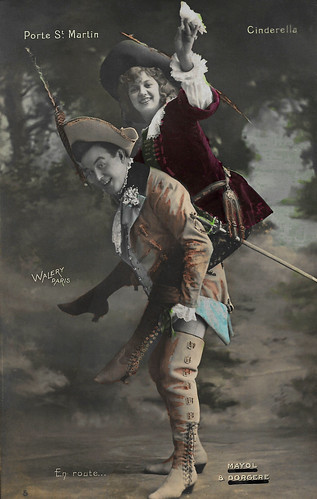
French postcard. Photo: Walery, Paris. Mayol as Dandy and Arlette Dorgère as Prince Charming in the stage production 'Cinderella' (1906) at Théâtre de la Porte Saint-Martin in Paris. Caption: en route.
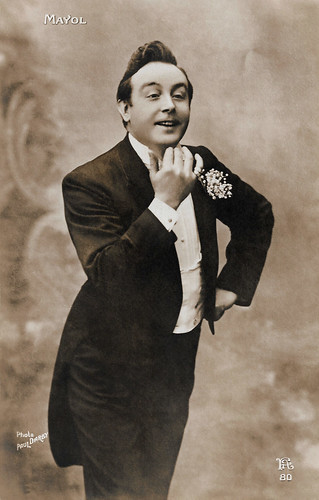
French postcard by F.A., no. 80. Photo: Paul Darby.
The flame of punch
Félix Antoine Henry Mayol was born in Toulon, France, in 1872. His parents were both amateur singers and actors, who arranged for Felix to make his debut stage at six years of age on the stages of Toulon and Marseille. Later, his brother Charles Mayol founded a music publishing company to print his works.
He became a success in Paris in 1895 as a singer performing in a campy, effeminate way. An anecdote published in his memoirs reports that for lack of finding a camellia, that the elegant men wore at the time on the revers of their frock coat, he took a bit of lily of the valley which became his emblem.
The improbable hair tassel he wore (and which gave him the nickname of "the red-toupeed artist" or "flame of punch") became so famous that it inspired many imitators. He knew his first great success in 1896 with 'La Paimpolaise' by Théodore Botrel.
In 1900, after a brief stint at the Eldorado where he sang 'À la cabane bambou', he was engaged by La Scala. It was there that he created the title that would make him both rich and famous: 'Viens, poupoule!' (1902), an adaptation of a German song arranged by Henri Christiné and Alexandre Trébitsch.
He returned in 1905 with 'La Matchiche', the adaptation of a fashionable Spanish dance song. The same year, he performed at Gaumont in 14 Phonoscènes under the direction of Alice Guy, such as La Paimpolaise. These were short sound films using a sound on disc system. He would record his voice, then the camera would film him as he lip-synced to the record. Several of these Phonoscènes still exist. Already, Mayol had to his credit many recordings on cylinders and on discs.
In 1907, Mayol's operetta 'Cinderella' at La Scala did not convince, unlike one of the show's songs, 'Les Mains de femmes' which became a success, followed in 1908 by 'Cousine'. His cachet then reached the sum of a thousand gold francs, which allowed him to buy in 1910 the Paris cabaret Concert which hence took his name, the Concert Mayol.
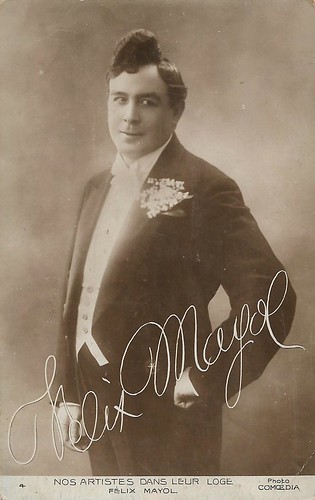
French postcard in the 'Nos artistes dans leur loge' series, no. 4. Photo: Comoedia, Paris.
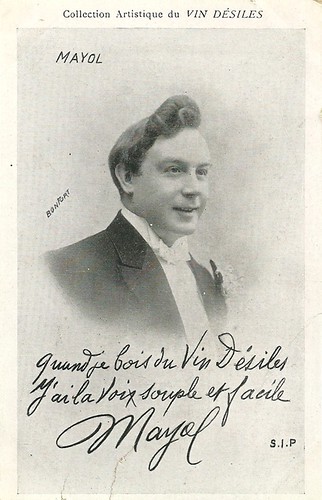
French postcard in the Collection Artistique du Vin Désiles by S.I.P. Photo: Bonfort. Caption: Whenever I drink Vin Désiles, my voice is flexible and easy.
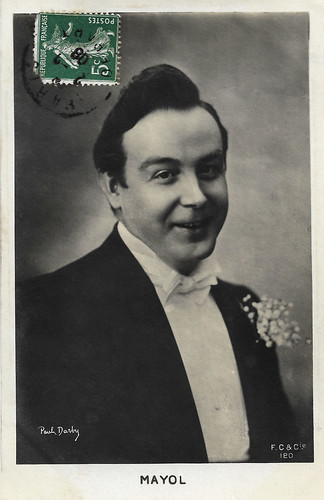
French postcard by F.C. & Cie., no. 120. Photo: Paul Darby.
Married to Mistinguett
Félix Mayol was the main star of the shows at the Concert Mayol, and in turn, he launched young artists, including Valentin Sardou (father of Fernand Sardou and grandfather of Michel Sardou), Maurice Chevalier , Émile Audiffred and Raimu .
In 1914 he passed the sceptre to Oscar Dufrenne. He then began a tour of the whole of France and the French-speaking countries with his Baret tours. His fame passed so well that even Charlie Chaplin came to listen. The period 1914-1918 was marked, as for many artists, by many anti-German songs, intended to maintain the morale of the troops.
Mayol's career stalled after the First World War. He published his 'Souvenirs' in 1929, made "seven farewell shows to the Paris public" in 1938 and retired to his hometown Toulon. He was attached to Toulon and particularly to his rugby club. Shortly after World War I, he purchased a plot of land in Toulon and donated it to the local sports club, RC Toulonnais, for the building of a stadium. He also offered 60,000 gold francs to finance the construction of the stadium which still bears his name, the stadium Mayol. The lily of the valley he loved became the emblem of the club and the sumptuous dinner he gave players to celebrate the title of 1931 has remained in the annals.
The traditional lily of the buttonhole was artificial because he could not bear the scent. Mayol's supposed or real homosexuality, linked to his celibacy and his "effeminate stage play", made Mayol a target of journalists. At the time, songwriters and other writers often referred to it, such as the marriage between Mayol and Mistinguett invented from scratch, resulting in a lot of laughter. Many stories circulated of his homosexual liaisons, including an attempt to seduce the young Maurice Chevalier .
Until now, no published direct testimony, with the exception of one, has been known in which the artist has openly evoked his sexual preferences. In his songs, often very gritty, Mayol employs most of the time the "we" of the male collective. These songs portray prostitutes or women always welcoming to the sexual encounter. According to his memoirs, Mayol created almost 500 songs. The French Wikipedia lists some 120 songs, based on the website Gallica and other sources.
After the 1905 phonoscènes series at Gaumont, Mayol acted in five more films, according to IMDb , three silent films, including Le filon du Bouif/The vein of Bouif (Louis Osmont, 1922), and two early sound films, the comedy Aux urnes, citoyens!/To the Polls, Citizens! (Jean Hémard, 1932) and La dame de chez Maxim's/The Girl from Maxim's (Alexander Korda, 1933) starring Florelle and based on the 1899 farce 'La Dame de chez Maxim' by Georges Feydeau.
Félix Mayol passed away in Toulon in 1941. He was 68.
Examples of the Mayol phonoscènes:
Phonoscène La Polka des Trottins/The Trottins Polka (Alice Guy Blache, 1905) with Félix Mayol. Source: CBGP Music (YouTube).
Phonoscène Lilas blanc/White Lilacs (Alice Guy Blache, 1905) with Félix Mayol. Source: CBGP Music (YouTube).
Phonoscène Questions indiscrèts/Indiscreet Questions (Alice Guy Blache, 1905) with Félix Mayol. Source: Camila Suzuki (YouTube).
Sources: BNF, Wikipedia (French and English) and .

French postcard. Photo: Walery, Paris. Mayol as Dandy and Arlette Dorgère as Prince Charming in the stage production 'Cinderella' (1906) at Théâtre de la Porte Saint-Martin in Paris. Caption: en route.

French postcard by F.A., no. 80. Photo: Paul Darby.
The flame of punch
Félix Antoine Henry Mayol was born in Toulon, France, in 1872. His parents were both amateur singers and actors, who arranged for Felix to make his debut stage at six years of age on the stages of Toulon and Marseille. Later, his brother Charles Mayol founded a music publishing company to print his works.
He became a success in Paris in 1895 as a singer performing in a campy, effeminate way. An anecdote published in his memoirs reports that for lack of finding a camellia, that the elegant men wore at the time on the revers of their frock coat, he took a bit of lily of the valley which became his emblem.
The improbable hair tassel he wore (and which gave him the nickname of "the red-toupeed artist" or "flame of punch") became so famous that it inspired many imitators. He knew his first great success in 1896 with 'La Paimpolaise' by Théodore Botrel.
In 1900, after a brief stint at the Eldorado where he sang 'À la cabane bambou', he was engaged by La Scala. It was there that he created the title that would make him both rich and famous: 'Viens, poupoule!' (1902), an adaptation of a German song arranged by Henri Christiné and Alexandre Trébitsch.
He returned in 1905 with 'La Matchiche', the adaptation of a fashionable Spanish dance song. The same year, he performed at Gaumont in 14 Phonoscènes under the direction of Alice Guy, such as La Paimpolaise. These were short sound films using a sound on disc system. He would record his voice, then the camera would film him as he lip-synced to the record. Several of these Phonoscènes still exist. Already, Mayol had to his credit many recordings on cylinders and on discs.
In 1907, Mayol's operetta 'Cinderella' at La Scala did not convince, unlike one of the show's songs, 'Les Mains de femmes' which became a success, followed in 1908 by 'Cousine'. His cachet then reached the sum of a thousand gold francs, which allowed him to buy in 1910 the Paris cabaret Concert which hence took his name, the Concert Mayol.

French postcard in the 'Nos artistes dans leur loge' series, no. 4. Photo: Comoedia, Paris.

French postcard in the Collection Artistique du Vin Désiles by S.I.P. Photo: Bonfort. Caption: Whenever I drink Vin Désiles, my voice is flexible and easy.

French postcard by F.C. & Cie., no. 120. Photo: Paul Darby.
Married to Mistinguett
Félix Mayol was the main star of the shows at the Concert Mayol, and in turn, he launched young artists, including Valentin Sardou (father of Fernand Sardou and grandfather of Michel Sardou), Maurice Chevalier , Émile Audiffred and Raimu .
In 1914 he passed the sceptre to Oscar Dufrenne. He then began a tour of the whole of France and the French-speaking countries with his Baret tours. His fame passed so well that even Charlie Chaplin came to listen. The period 1914-1918 was marked, as for many artists, by many anti-German songs, intended to maintain the morale of the troops.
Mayol's career stalled after the First World War. He published his 'Souvenirs' in 1929, made "seven farewell shows to the Paris public" in 1938 and retired to his hometown Toulon. He was attached to Toulon and particularly to his rugby club. Shortly after World War I, he purchased a plot of land in Toulon and donated it to the local sports club, RC Toulonnais, for the building of a stadium. He also offered 60,000 gold francs to finance the construction of the stadium which still bears his name, the stadium Mayol. The lily of the valley he loved became the emblem of the club and the sumptuous dinner he gave players to celebrate the title of 1931 has remained in the annals.
The traditional lily of the buttonhole was artificial because he could not bear the scent. Mayol's supposed or real homosexuality, linked to his celibacy and his "effeminate stage play", made Mayol a target of journalists. At the time, songwriters and other writers often referred to it, such as the marriage between Mayol and Mistinguett invented from scratch, resulting in a lot of laughter. Many stories circulated of his homosexual liaisons, including an attempt to seduce the young Maurice Chevalier .
Until now, no published direct testimony, with the exception of one, has been known in which the artist has openly evoked his sexual preferences. In his songs, often very gritty, Mayol employs most of the time the "we" of the male collective. These songs portray prostitutes or women always welcoming to the sexual encounter. According to his memoirs, Mayol created almost 500 songs. The French Wikipedia lists some 120 songs, based on the website Gallica and other sources.
After the 1905 phonoscènes series at Gaumont, Mayol acted in five more films, according to IMDb , three silent films, including Le filon du Bouif/The vein of Bouif (Louis Osmont, 1922), and two early sound films, the comedy Aux urnes, citoyens!/To the Polls, Citizens! (Jean Hémard, 1932) and La dame de chez Maxim's/The Girl from Maxim's (Alexander Korda, 1933) starring Florelle and based on the 1899 farce 'La Dame de chez Maxim' by Georges Feydeau.
Félix Mayol passed away in Toulon in 1941. He was 68.
Examples of the Mayol phonoscènes:
Phonoscène La Polka des Trottins/The Trottins Polka (Alice Guy Blache, 1905) with Félix Mayol. Source: CBGP Music (YouTube).
Phonoscène Lilas blanc/White Lilacs (Alice Guy Blache, 1905) with Félix Mayol. Source: CBGP Music (YouTube).
Phonoscène Questions indiscrèts/Indiscreet Questions (Alice Guy Blache, 1905) with Félix Mayol. Source: Camila Suzuki (YouTube).
Sources: BNF, Wikipedia (French and English) and .
Published on February 26, 2020 22:00
Paul van Yperen's Blog
- Paul van Yperen's profile
- 13 followers
Paul van Yperen isn't a Goodreads Author
(yet),
but they
do have a blog,
so here are some recent posts imported from
their feed.



